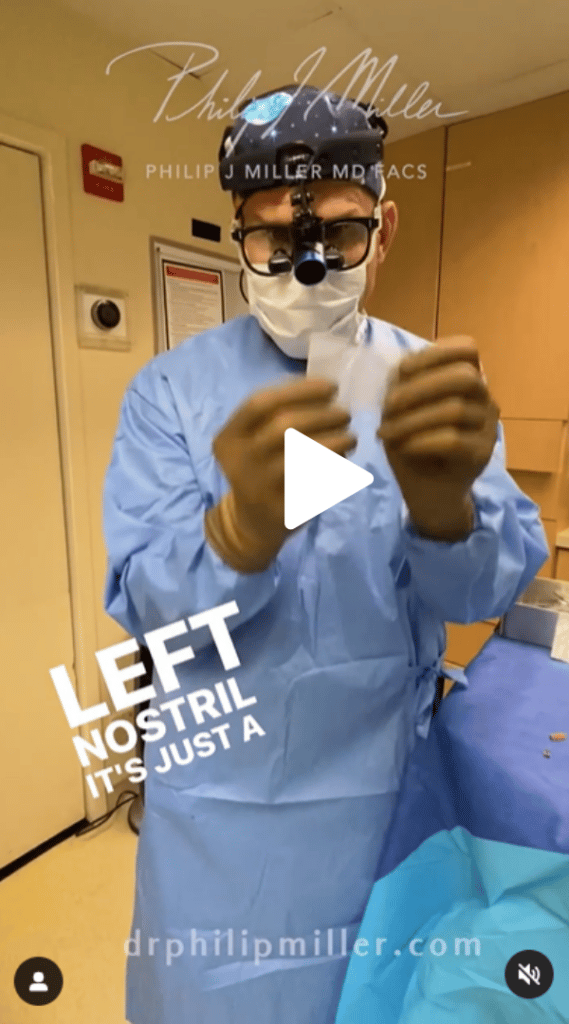How Rhinoplasty Can Boost Confidence Before the Holiday Season
As the holiday season approaches, it’s natural to start preparing for joyful gatherings, festive photos, and meaningful reunions. Beyond the perfect outfit or celebration plans, true confidence often comes from feeling comfortable in your own skin.
For those who have long felt self-conscious about the shape or size of their nose, rhinoplasty in NYC offers the opportunity to step into the season with renewed confidence and balance. At Philip J. Miller, MD, FACS, a double board-certified facial plastic surgeon, helps patients reveal their best features through personalized rhinoplasty techniques that enhance harmony, not hide individuality.Understanding how the nose’s structure influences your overall appearance is key to appreciating the artistry behind each transformation. That begins with the nasal bridge, a foundational element in both facial balance and rhinoplasty design.
Understanding the Nasal Bridge and How It Shapes Your Appearance
The nasal bridge, which forms the upper third of the nose, plays a vital role in determining its shape, height, and proportion with the rest of your facial features. Even minor irregularities or asymmetries in this area can affect how light and balance are perceived across the face.
With deep expertise in facial anatomy and advanced surgical precision, Dr. Miller refines the nasal bridge, cartilage, and soft tissue to achieve natural, balanced results that complement each patient’s unique features. This combination of science and artistry ensures that enhancements appear seamless and authentic.
To better understand how your nasal structure contributes to facial aesthetics, explore our detailed Anatomy of the Nose guide.
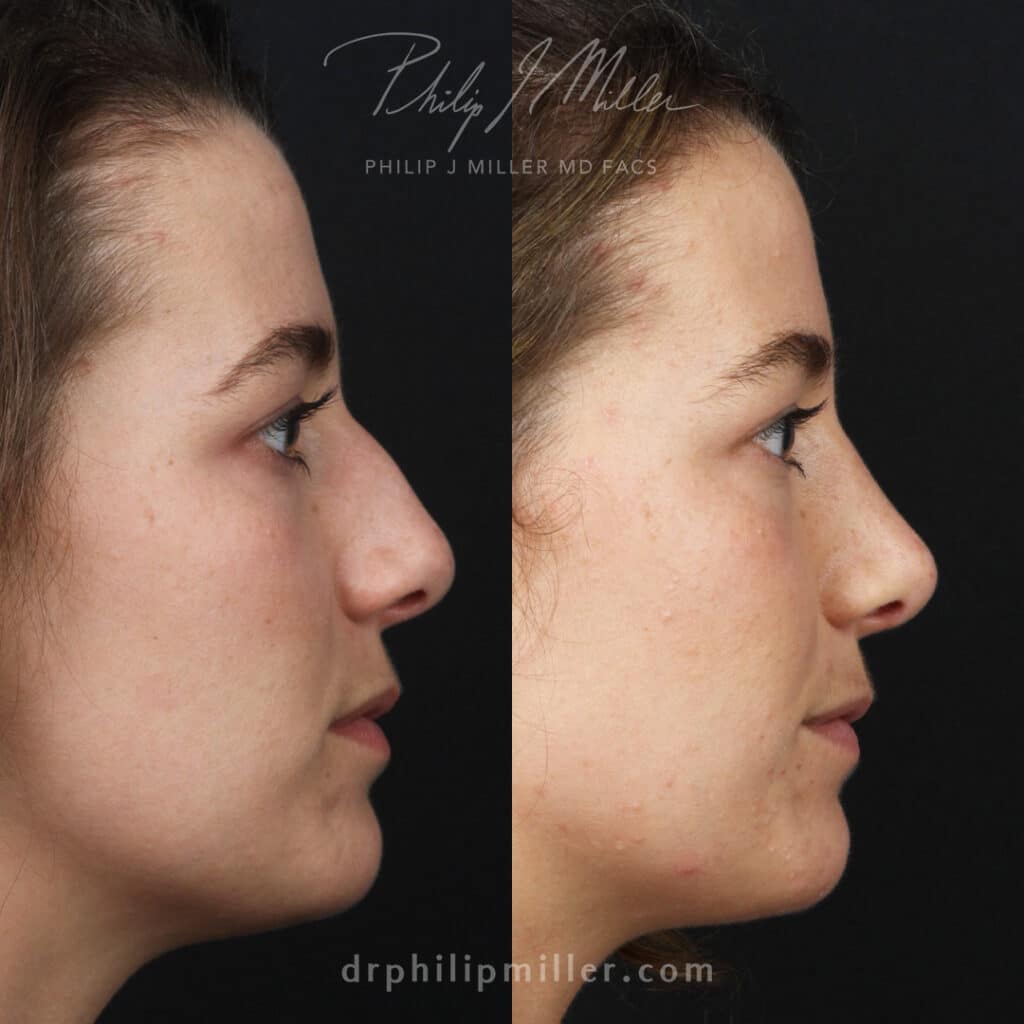
Why Rhinoplasty Can Boost Your Confidence Before the Holidays
The holidays bring countless occasions to shine, by capturing memories, celebrating with loved ones, and embracing every moment with confidence. If you’re considering rhinoplasty in NYC, there’s no better expert than Dr. Philip J. Miller, whose refined approach helps patients look and feel their best before the festive season begins.
Benefits of Pre-Holiday Rhinoplasty Include:
- Enhances facial balance and overall harmony
- Boost self-esteem and photo confidence
- Provides natural, subtle improvements that look effortless
- Personalized approach designed by a double board-certified expert
Dr. Miller’s signature NatraNose® approach focuses on natural-looking outcomes, refining, not redefining, your features so your confidence shines naturally.
What to Expect During Rhinoplasty Recovery
One of the biggest questions patients ask before surgery is, “how long will rhinoplasty recovery take?” The good news is that with Dr. Miller’s advanced techniques, recovery is typically smooth and manageable.
Typical Rhinoplasty Recovery Time
Most patients can return to work and light social activities within one to two weeks. Bruising and swelling gradually subside during this period, while the nasal contour continues to refine over several months. Planning ahead allows you to recover comfortably and enjoy your refreshed look before the holiday festivities begin.
Tips for a Smooth Rhinoplasty Recovery
- Follow all post-operative instructions carefully
- Keep your head elevated when resting
- Avoid pressure or glasses on the nose during early healing
- Stay hydrated and maintain a nutrient-rich diet
- Schedule surgery at least six to eight weeks before any major events
With attentive aftercare and Dr. Miller’s personalized healing procedures, you can enjoy a confident, camera-ready look just in time for your first holiday party.
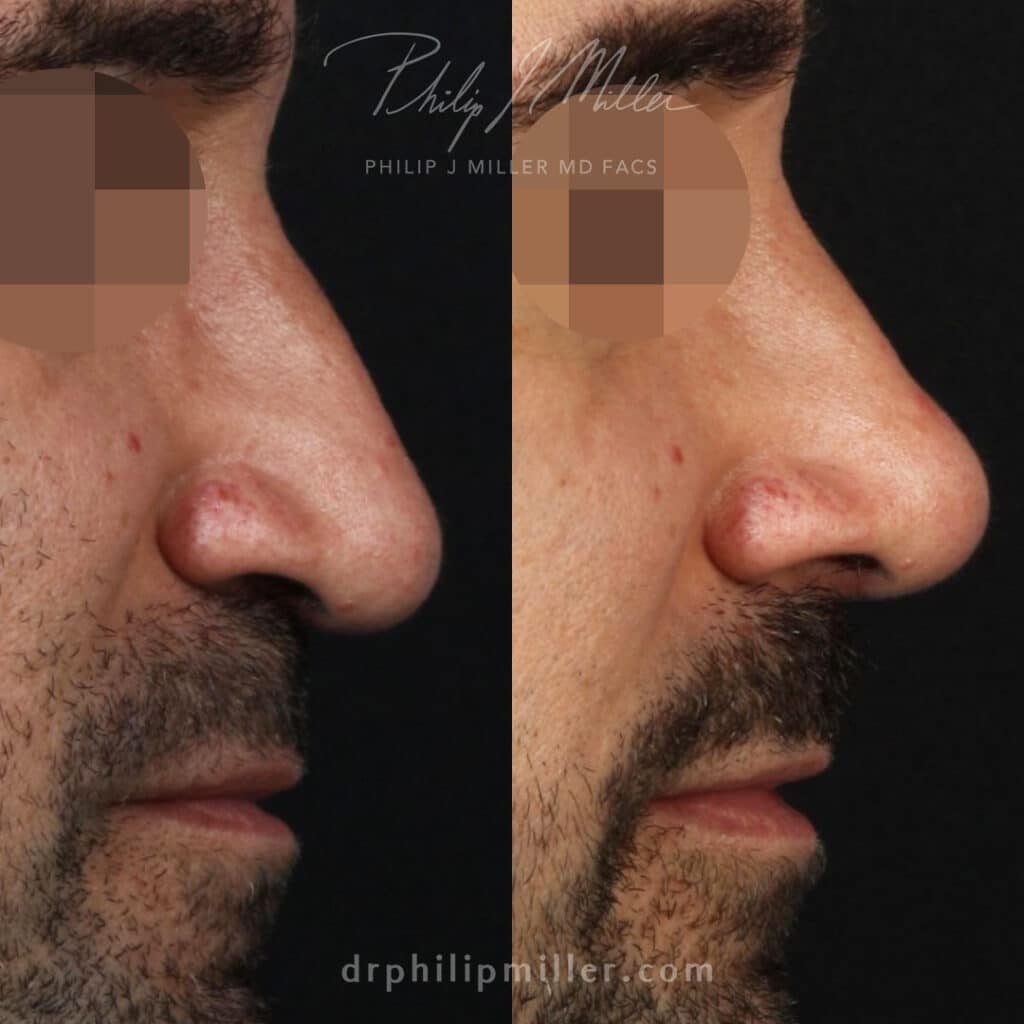
What Is Microrhinoplasty and How Can It Enhance Your Look Before the Holidays?
When it comes to rhinoplasty, there isn’t just one approach. For those seeking subtle refinement rather than a major change, Microrhinoplasty offers a minimally invasive solution. This technique allows Dr. Miller to make subtle adjustments, like smoothing small bumps or refining the nasal bridge contour, without the longer recovery of traditional surgery.
Perfect for patients wanting to look refreshed and photo-ready before the holidays, microrhinoplasty delivers natural, harmonious results with minimal downtime.
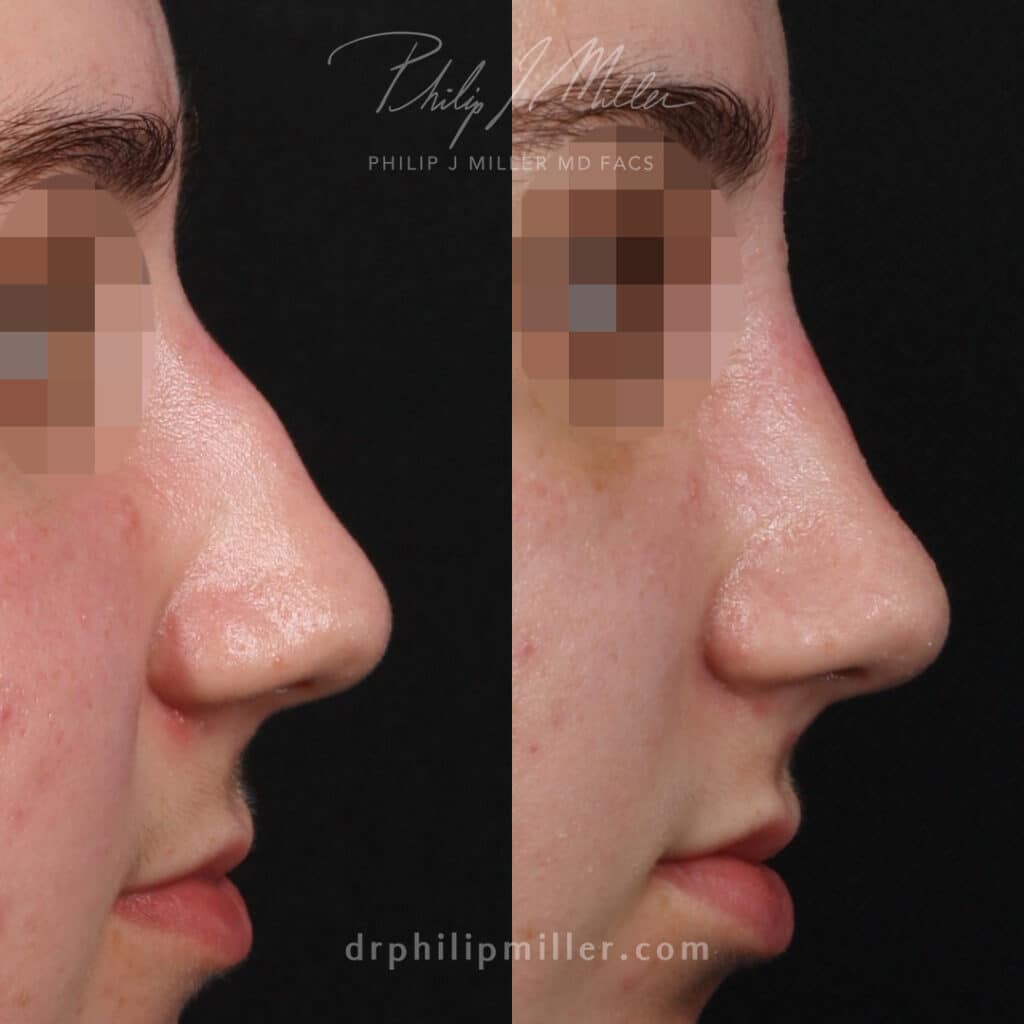
Why Choose Philip J. Miller, MD, FACS, for Your Rhinoplasty in NYC
When it comes to facial refinement, experience matters. Dr. Miller is nationally recognized for his artistry, precision, and dedication to achieving results that look authentic and beautifully balanced.
The NatraNose® Advantage:
- Double board certification in facial plastic and reconstructive surgery
- Precision reshaping of the nasal bridge for improved contour and symmetry
- Advanced 3D imaging to visualize results before surgery
- Natural, individualized results that enhance, not alter, your features
Dr. Miller’s approach prioritizes harmony between the nose and the rest of your face, ensuring you look like the best version of yourself, not someone else.
A Holiday Transformation You Deserve
Whether you are refining a bump along the nasal bridge, narrowing the bridge, or restoring balance after injury, a rhinoplasty can help you feel as good as you look.
The confidence that comes with loving your reflection is the best gift you can give yourself this holiday season, and it lasts long after the decorations come down.
Step into the Holidays with Confidence
Transform the way you feel about your reflection. Book your consultation with Dr. Miller today and discover how expertly performed rhinoplasty in NYC can help you look refreshed, refined, and completely yourself.
FAQs About Rhinoplasty Recovery and Results
Q: How long after rhinoplasty recovery time can I attend holiday events?
Most patients feel comfortable returning to social events within 10 to 14 days after surgery, though subtle refinement continues for several months.
Q: Does rhinoplasty change the nasal bridge?
Yes. During surgery, Dr. Miller can precisely reshape the nasal bridge to smooth bumps, straighten asymmetry, and improve overall facial balance.
Q: Why choose rhinoplasty in NYC before the holidays?
Scheduling your rhinoplasty in NYC early in the season allows you to recover fully and enjoy visible improvements in time for family photos, gatherings, and celebrations.
Upturned Nose: What It Means and How Rhinoplasty Can Refine Your Profile
What if one small change could bring your entire face into harmony? Whether you’ve always had a slightly upturned tip or feel your nostrils appear too visible in photos, an upturned nose can create facial dynamics that some love and others wish to refine.
Philip J. Miller, MD, FACS combines surgical artistry with advanced technology to help patients achieve facial harmony through his signature NatraNose® approach. With double board certification in facial plastic and reconstructive surgery, Dr. Miller specializes in natural, balanced results that highlight your best features.
If you’re curious about how rhinoplasty in NYC can subtly reshape your upturned nose, this guide explains what causes it, why people seek change, and how expert refinement can help you look and feel your best.
Why Some People Seek Rhinoplasty for an Upturned Nose
Every nose tells a story. For some, an upturned nose feels charmingly unique. For others, it draws unwanted attention.
Common reasons patients choose rhinoplasty for upturned noses include:
- Refining proportions – creating coordination between the nose, lips, and chin.
- Reducing nostril visibility – especially noticeable in profile or front-facing photos.
- Correcting over-rotation – often after a prior surgery.
- Improving symmetry or breathing – when structural irregularities affect airflow.
Many of Dr. Miller’s patients have admired the results of friends or coworkers who had successful rhinoplasties and feel ready to take the next step toward a natural, confidence-boosting transformation. His philosophy centers on balance and authenticity: your features, only better.
Rhinoplasty in NYC: How Dr. Miller Refines the Upturned Nose
Customized Evaluation
Every face is unique, and so is every nose. Dr. Miller begins each rhinoplasty consultation in NYC with a comprehensive facial analysis using Vectra 3D imaging technology. This imaging allows patients to preview their potential results before committing to surgery.
This advanced system enables precise adjustments to tip projection and rotation, helping create a realistic vision of what your refined profile could look like.
Surgical Precision and Artistic Balance
Through his exclusive NatraNose technique, Dr. Miller combines surgical precision with aesthetic artistry to produce subtle, natural refinements. Depending on your anatomy and goals, treatment may include:
- Adjusting nasal tip rotation and projection
- Using cartilage grafts for stability and structure
- Correcting asymmetry or prior over-rotation (revision rhinoplasty)
- Enhancing nasal balance without altering your overall character
As a double-board-certified facial plastic surgeon, Dr. Miller’s expertise extends beyond technique. He understands how even the smallest adjustment can impact overall facial harmony.
Natural Results You Will Love
Dr. Miller’s patients consistently describe their results as still themselves, just better. The goal is never to erase your individuality but to enhance it. Results appear smooth, proportionate, and natural from every angle, helping you feel confident and camera-ready with or without filters.
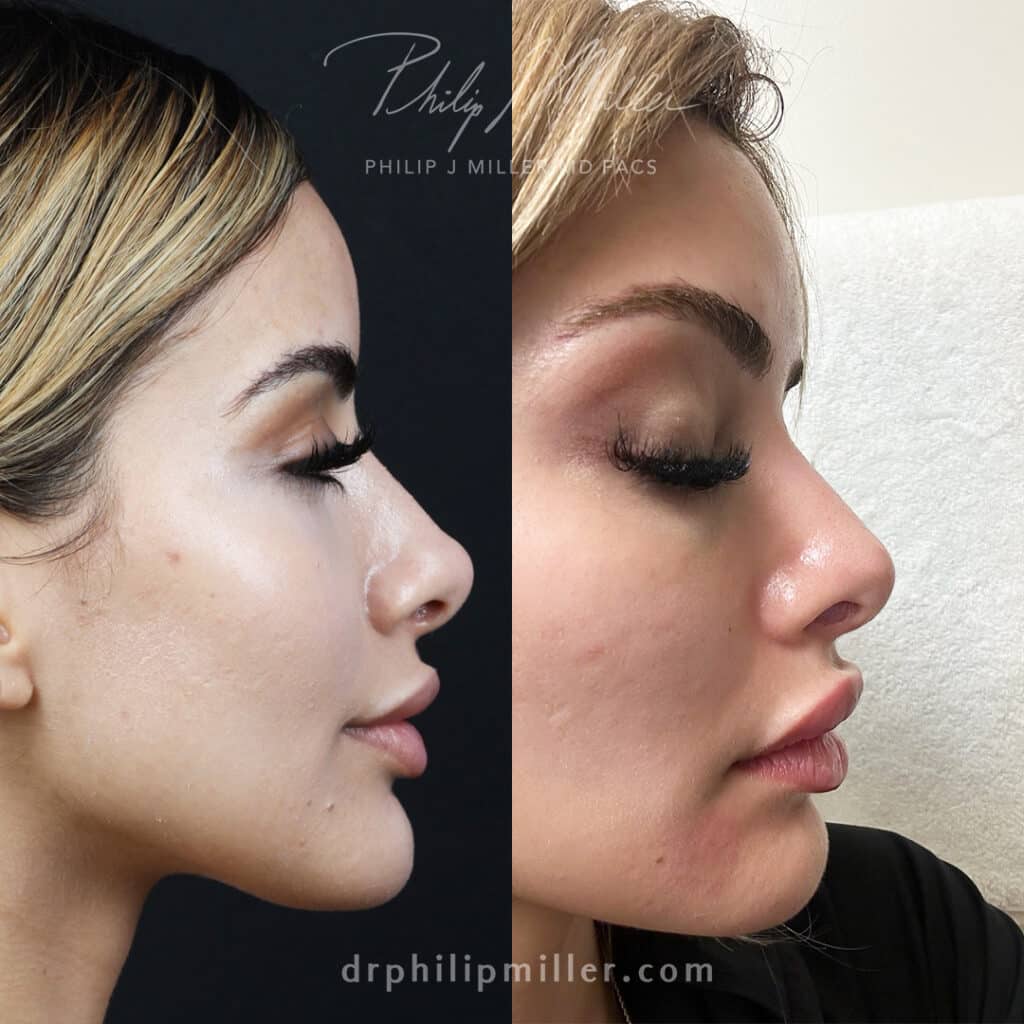
What to Expect from Rhinoplasty for an Upturned Nose
Consultation and Planning
Your journey begins with an in-depth conversation with Dr. Miller and his expert team. Together, they will review your goals, discuss options, and use 3D Vectra imaging to design your personalized plan.
This approach ensures every procedure is guided by Dr. Miller’s Unified Vision® philosophy. Together, there is a shared understanding of your aesthetic goals and how to achieve them safely and beautifully.
Procedure Overview
Performed in Dr. Miller’s Joint Commission-accredited surgical suite in Midtown Manhattan, rhinoplasty typically takes two to three hours under general anesthesia. Every incision is made with precision for minimal scarring and optimal healing.
The surgical plan focuses on refining rather than reshaping, creating seamless balance with the rest of your features.
Recovery and Results
Most patients experience mild swelling for one to two weeks and return to normal routines within 10 days. As healing continues, your nose settles into its final shape over several months, subtle, soft, and perfectly proportioned.
Dr. Miller and his team provide detailed aftercare and ongoing support to ensure your results look beautiful and natural long-term.
Why Choose Philip J. Miller, MD, FACS for Rhinoplasty in New York City
Choosing a surgeon is as personal as choosing your aesthetic goals. Dr. Miller stands apart for his:
- Double board certification in facial plastic and reconstructive surgery
- 20 years of specialized experience performing rhinoplasty and revision cases
- Artistic precision guided by advanced 3D technology
- Focus on natural results through proprietary techniques like NatraNose® and Unified Vision®
Patients travel from across New York, the U.S., and beyond to experience the exceptional care and artistry.
Refine and Redefine Your Beauty: Transforming an Upturned Nose with Rhinoplasty
Your nose plays a central role in the harmony of your face and even the smallest adjustment can have a powerful impact. For those with an upturned nose, achieving balance is about more than aesthetics; it is about confidence, proportion, and feeling aligned with how you see yourself.
Philip J. Miller, MD, FACS uses his advanced NatraNose® technique to help patients achieve results that are elegant, natural, and authentically their own. Through precision and artistry, Dr. Miller ensures every rhinoplasty complements, not changes, your facial identity.
Ready to Enhance Your Profile?
If you feel self-conscious about your nose, now is the perfect time to explore rhinoplasty in NYC with Dr. Miller.
Schedule your consultation today and discover how balance meets artistry when your best features shine effortlessly.
Considering Rhinoplasty? What to Know Before Summer
As summer approaches, many patients begin contemplating rhinoplasty to enhance their appearance before the season of outdoor activities, vacations, and social gatherings. While the warmer months might seem like the perfect time for a nose enhancement, there are several important factors to consider regarding timing, recovery, and protection that can significantly impact your rhinoplasty experience and results.
Understanding Your Rhinoplasty Options for Summer
At our Manhattan, New York, and New Orleans, Louisiana practices, we offer several approaches to rhinoplasty that can accommodate different summer timelines and aesthetic goals:
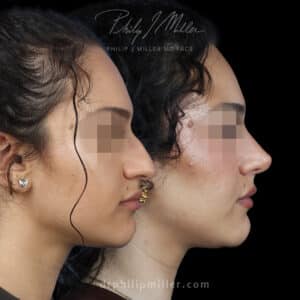
Traditional Rhinoplasty
Our comprehensive surgical rhinoplasty provides the most dramatic and permanent results for reshaping your nose. This option requires the most recovery time but delivers transformative results for those with significant aesthetic or functional concerns.
MicroRhinoplasty™
For patients seeking subtle refinement of their nasal bridge contour, our innovative MicroRhinoplasty™ offers a less invasive alternative with significantly shorter recovery time. Unlike traditional rhinoplasty that may require bone fracturing (osteotomy), MicroRhinoplasty™ uses an air-powered microrasp to precisely refine the nasal profile layer by layer, creating smoother, more harmonious facial proportions.
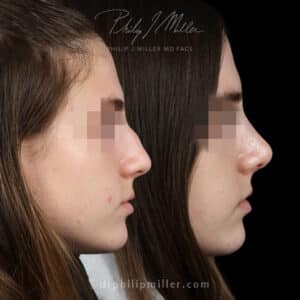
The benefits of MicroRhinoplasty™ for summer planning include:
- Procedure completed in as little as 5 minutes under local anesthesia
- Minimal pain, swelling, and bruising
- Return to normal activities within 1-2 days
- Precision results for specific nasal bridge concerns
Non-Surgical Rhinoplasty
For patients who want enhancement with virtually no downtime, our non-surgical rhinoplasty (or “liquid rhinoplasty”) offers immediate results using injectable fillers to reshape and refine the nose without surgery. This quick procedure can:
- Correct nasal irregularities
- Refine the nasal tip
- Enhance symmetry
- Camouflage mild humps
- Provide immediate results with minimal downtime
Results typically last between 8 and 24 months, making this an excellent option for those who want a summer-ready nose with no surgical recovery.
Timing Your Rhinoplasty for Optimal Summer Results
If you’re dreaming of showing off your new profile at summer events, planning ahead is essential. Each rhinoplasty approach requires different timing considerations:
Traditional Rhinoplasty Timeline
Most patients experience visible bruising and swelling for 1-2 weeks following traditional rhinoplasty surgery. While you’ll be presentable after your splint is removed (typically after one week), residual swelling can persist for several months. The most noticeable improvements occur within the first month, but your nose continues to refine and settle into its final shape over the course of a year.
For summer planning purposes, I recommend scheduling your traditional rhinoplasty at least 4-6 weeks before any major events or vacations. This timeline allows for:
- Initial healing of visible bruising and swelling
- Removal of all external dressings and splints
- Return to most normal activities
- Sufficient healing before exposure to summer elements
MicroRhinoplasty™ Timeline
With significantly less downtime than traditional rhinoplasty, MicroRhinoplasty™ can be scheduled much closer to summer events. Most patients can return to normal activities within 1-2 days, though strenuous activity should be avoided for 4-6 weeks. For optimal results, schedule your MicroRhinoplasty™ at least 2-3 weeks before major summer events.
Non-Surgical Rhinoplasty Timeline
The ultimate option for last-minute summer enhancement, non-surgical rhinoplasty delivers immediate results with virtually no downtime. Most patients can schedule this procedure just days before an important event, as any minor swelling typically resolves within 24-48 hours.
Recovery From Rhinoplasty: What to Expect
Understanding the recovery process is crucial for planning your summer rhinoplasty. Here’s what to expect during the weeks following your procedure:
First Week After Surgery
- You’ll wear a splint for protection and support
- Expect bruising and swelling around the nose and eyes
- Sleep with your head elevated to minimize swelling
- Avoid strenuous activities and keep the nose protected
- Have someone with you for the first 24-48 hours after surgery
2-3 Weeks After Surgery
- Most visible bruising and swelling will subside
- You’ll feel comfortable going out in public
- Makeup can be used to cover any residual discoloration
- Nasal congestion should begin to improve
- You can resume light activities like walking
3-6 Weeks After Surgery
- Resume cardiovascular activities like jogging and swimming
- Visible swelling and bruising should be virtually gone
- Breathing should continue to improve as internal swelling decreases
- You can typically resume wearing glasses around 6 weeks post-surgery
Full Recovery Timeline
While you’ll look presentable within a few weeks, complete healing takes time. Most patients see their final results develop over 6-12 months as subtle swelling continues to resolve and the nasal structures fully settle.
Summer-Specific Rhinoplasty Considerations
Sun Exposure Precautions
One of the most critical factors to consider for summer rhinoplasty is sun protection. The skin on your nose will be particularly sensitive following surgery, and excessive sun exposure can lead to:
- Increased or prolonged swelling
- Hyperpigmentation of surgical scars
- Delayed healing
- Compromised aesthetic results
For at least three months following rhinoplasty, it’s imperative to:
- Apply broad-spectrum SPF 30+ sunscreen to your nose daily
- Wear a wide-brimmed hat when outdoors
- Limit direct sun exposure, especially during peak hours
- Consider seeking shade whenever possible
Water Activities and Swimming
Many patients wonder when they can resume swimming and water activities after rhinoplasty. While each patient’s recovery varies, general guidelines include:
- Wait at least 3-4 weeks before swimming in pools
- Postpone ocean swimming for 4-6 weeks due to salt water and potential contaminants
- Avoid diving and underwater swimming for at least 6 weeks
- Use extra caution with water sports to prevent accidental trauma to the nose
For non-surgical rhinoplasty patients, swimming can typically be resumed within 24-48 hours, while MicroRhinoplasty™ patients should wait at least 1-2 weeks.
Heat and Humidity Considerations
Summer heat and humidity can sometimes exacerbate swelling after rhinoplasty. To manage this effectively:
- Stay in climate-controlled environments when possible during peak healing
- Use cold compresses as directed to reduce swelling
- Stay well-hydrated
- Consider scheduling indoor activities during the hottest parts of the day
The NatraLook® Approach to Summer Rhinoplasty
At our practice, we utilize the exclusive NatraLook® process to ensure your rhinoplasty results align perfectly with your aesthetic goals. This approach is particularly valuable when planning a summer rhinoplasty, as it helps create a unified vision for your outcome that complements your overall summer confidence.
The NatraLook® consultation process involves:
- Comprehensive evaluation of your nasal structure and facial features
- Detailed discussion of your aesthetic goals and summer timeline
- Collaborative planning for natural-looking results that enhance your confidence
- Creation of a personalized treatment approach that considers your summer activities and events
Is Spring the Ideal Time for Rhinoplasty?
For many patients, spring represents the optimal time to undergo rhinoplasty with summer in mind. Scheduling your procedure in spring allows:
- Sufficient recovery time before summer vacations and events
- Cooler weather during the initial healing phase
- Less sun exposure during critical healing weeks
- Time to adapt to your new appearance before summer social gatherings
Most patients find that having their traditional rhinoplasty in April or May provides ample time to be fully “summer-ready” by late June or July. For MicroRhinoplasty™ or non-surgical options, procedures can be scheduled much closer to summer events.
Choosing the Right Rhinoplasty Approach for Your Summer Timeline
When considering rhinoplasty before summer, it’s important to align your aesthetic goals with your timeline:
- 6+ weeks before summer events: Ideal for traditional rhinoplasty with comprehensive reshaping
- 2-3 weeks before summer events: Perfect timing for MicroRhinoplasty™ for dorsal hump reduction
- Days before summer events: Non-surgical rhinoplasty for immediate enhancement with no downtime
During your consultation, we’ll discuss which approach is best suited to your specific needs, goals, and summer timeline.
The Benefits of a Pre-Summer Rhinoplasty
Beyond practical recovery considerations, there are several advantages to completing your rhinoplasty before summer:
- Enjoying your summer with enhanced confidence in your appearance
- Having your new profile featured in summer photos and memories
- Addressing both aesthetic concerns and functional issues (like breathing difficulties) before outdoor activity season
- Completing the most significant portion of your healing during a less socially demanding time
Rhinoplasty Near Me: Expert Care in Manhattan and New Orleans
Whether you’re in Manhattan, New York, or New Orleans, Louisiana, our specialized rhinoplasty expertise is accessible to you. As a double board-certified facial plastic surgeon with over two decades of experience, I provide patients with exceptional care and natural-looking rhinoplasty results that enhance summer confidence.
Schedule Your Consultation Today
If you’re considering rhinoplasty before summer, now is the ideal time to schedule a consultation. Together, we’ll create a personalized plan that aligns with your aesthetic goals and summer timeline.
Contact our Manhattan, New York or New Orleans, Louisiana, office today to begin your rhinoplasty journey and ensure you’re ready to put your best face forward this summer.
8 Common Signs of a Bad Rhinoplasty
As the central feature on the face, the nose has a profound impact on your appearance overall. Rhinoplasty is a plastic surgery procedure that can reshape and resize the nose to create facial harmony. When performed by a highly trained, board-certified plastic surgeon, rhinoplasty can provide seamless alterations and coveted results. However, it is also a delicate process that can go less than perfect at times, sometimes requiring a revision surgery to produce a better result.
Signs of a bad nose job
A bad nose job can lead to cosmetic and functional problems, and the need for revision rhinoplasty. Wondering if you’ve experienced a bad rhinoplasty? Here are the most common signs of a bad nose job:
1. Bridge is Too Low (Scooped Profile)
A low bridge can occur when a surgeon uses a chisel or osteotome. This tool requires precision and can effectively remove a portion of the bridge in one movement. Sometimes that movement is in the wrong place, or the tool can remove too much tissue or cartilage, creating a bridge that is too low. From the side, it can look like a scooped profile. In some cases, the chisel can cause severe damage and weaken the nasal structure, leading to a collapsed nose.
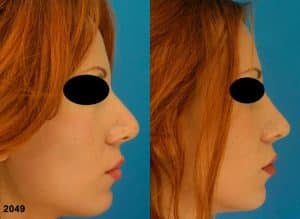
2. Nose Looks Pinched (also pinched nostrils)
After a rhinoplasty procedure, the nose or nostrils can look pinched, making the nose look long and slender. Not only can this bad nose job look unsightly, but it can also result in difficulty breathing due to a narrow passageway that does not allow enough airflow. This common sign of a botched rhinoplasty can result from removing too much internal nostril tissue, resulting in slits for nostrils rather than round holes. It is important to correct this mistake for adequate breathing.
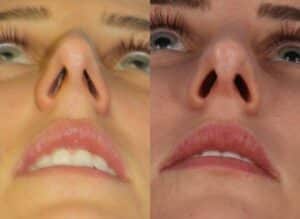
3. Nose Turns Up Too Much
When a rhinoplasty aims to shorten the nose, it can lead to many common side effects that rotate the tip upward too much or leave the tip at an irregular angle. Large amounts of removed tissue from the septum is a poor attempt to raise the nose and a sign of a bad nose job. A nose that is turned up too much can look like a pig snout. This effect is also common due to swelling after surgery but swelling-related issues should dissipate in several weeks. If the nose tip does not drop during the recovery process, revision surgery may be necessary.
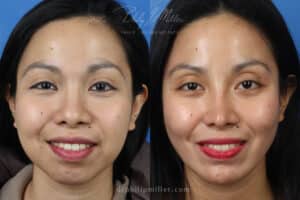
4. Nose Has Pollybeak Deformity
Pollybeak deformity is when the area above the tip is too full and makes the nose protrude downward, looking like a bird beak. This can occur from unpredictable healing but is most often due to a bad nose job. Sometimes not enough cartilage is removed, and the excess tissue in the supratip area can force the nose shape downward. In addition to the cosmetic concern, this mistake can also result in difficulty breathing from one or both nostrils. Pollybeak deformity can also occur due to aggressive removal of a dorsal hump without considering reshaping the area and remaining tissue.
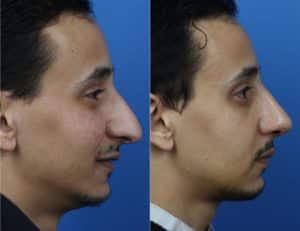
5. Nasal Tip is Same Width as Bridge
In a typical nose shape, the tip should be slightly wider than the bridge for an appealing and cohesive form. A bad rhinoplasty procedure overlooks this knowledge when reshaping and sizing problem areas. When the nasal tip and bridge are the same width, the nose can look unnatural.
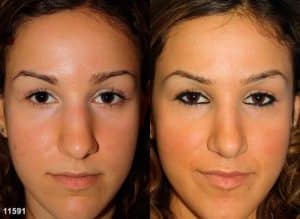
6. Nostrils are Too Wide or Asymmetrical
As a prominent feature, any mistake on the nose is highly noticeable. Disproportionate or asymmetrical nostrils are a common sign of a bad nose job and can be easily prevented with exceptional skill and a strong sense of aesthetics.
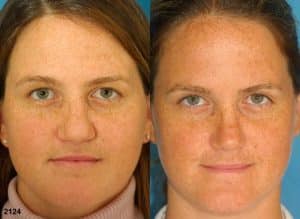
7. Nose is Not Proportionate to Other Facial Features
The main goal of rhinoplasty is to create facial balance and an aesthetically pleasing nose shape and size that flows seamlessly with other features. When a nose job is poorly executed, it can look like your nose does not belong with your other features. Rhinoplasty must be a personalized procedure to ensure proper proportion and flow.
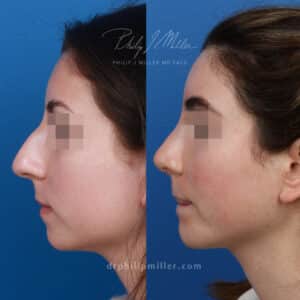
8. You Notice Breathing Difficulty
A cosmetic nose job should not impact the function of the nose. Difficulty breathing is a sure sign of a bad nose job. This error is more common with reductive procedures as too much tissue or cartilage is removed, reducing the internal and external passageway for poor airflow.
Revision rhinoplasty surgeon in New York
If you had a bad rhinoplasty procedure, you may be a candidate for revision rhinoplasty. Revision procedures are often more complex than the initial nose job, so it is critical to choose an experienced, skilled surgeon to perform your procedure and ensure a better outcome.
About Dr. Miller in NYC
Philip J. Miller, MD, FACS, is a double-board certified facial plastic surgeon specializing in cosmetic facial procedures that help patients achieve their aesthetic goals. Dr. Miller is a leading expert in rhinoplasty and facial rejuvenation, focusing on comprehensive treatment plans for natural results. He uses the NatraLook® process, which empowers patients to explore their aesthetic beauty and provides a supportive space to discuss a unified vision.
Contact us to schedule a consultation at our New York or New Orleans office and learn more about rhinoplasty and revision rhinoplasty.
Why do you have to wear a cast after rhinoplasty?
There are many types of rhinoplasty procedures, and some require a nose cast, or nasal splint, after the procedure to protect, compress, and position the nose. Nose casts can be created with a series of nasal tape applications and adhesive foam applied outside the nose during the initial healing process. The type of cast and suggested timeframe to wear the nose cast after surgery depend on your personalized treatment recovery plans.
Why Dr. Miller Uses a Cast After Rhinoplasty
Dr. Miller strives to provide patients with a positive rhinoplasty experience. To ensure optimal healing, he uses nasal casts to aid in post-operative recovery. A nose cast after rhinoplasty is a protective tool that ensures an effective recovery. The cast can be used to:
- Protect the nose from injury while it is healing
- Compress the nose to reduce swelling and minimize side effects such as drainage or bleeding
- Position the nose correctly so it remains in place during healing
There are many factors that can be addressed during a rhinoplasty procedure that can produce different side effects and recovery time. For example, restructuring bones may require additional healing and a different type of nose cast than a rhinoplasty that focuses on a bulbous tip or nostril reshaping. Dr. Miller takes time with each patient to review appropriate aftercare instructions and recovery expectations.
How is the cast applied?
After the rhinoplasty procedure, the nose cast is applied outside the nose to provide support and help reduce side effects such as swelling. Depending on your surgical procedure, the cast may vary. Surgical-grade tape is cut to length and secured with adhesive foam. Several layers of this process create a stiff cast-like covering to protect the nose and keep it in place. Gentle pressure is applied to the nose cast to ensure it forms in the correct shape and provides compression. The splint is durable and should not move or become loose before the appropriate time to remove it.
When is it safe to remove the cast after rhinoplasty?
A typical surgical rhinoplasty procedure requires a nose cast for six to seven days. Patients with a liquid rhinoplasty do not require a nose cast, and patients who received a micro rhinoplasty procedure only require a nasal splint for three days.
The nose cast is meant to allow the nose to set into its new shape and begin healing without harm or injury. The post-operative protective tool significantly impacts the long-term results and recovery after surgery.
Philip J. Miller, MD, FACS, is a world-renowned facial plastic surgeon with more than two decades of experience. He specializes in cosmetic facial procedures and is a leading expert in rhinoplasty and facial rejuvenation. Dr. Miller strives to create natural results with the NatraLook® process. This enriching experience helps patients explore their aesthetic beauty goals in a safe and supportive environment. NatraLook allows patients to partner with Dr. Miller and design a unified vision for natural and unmatched surgical results.
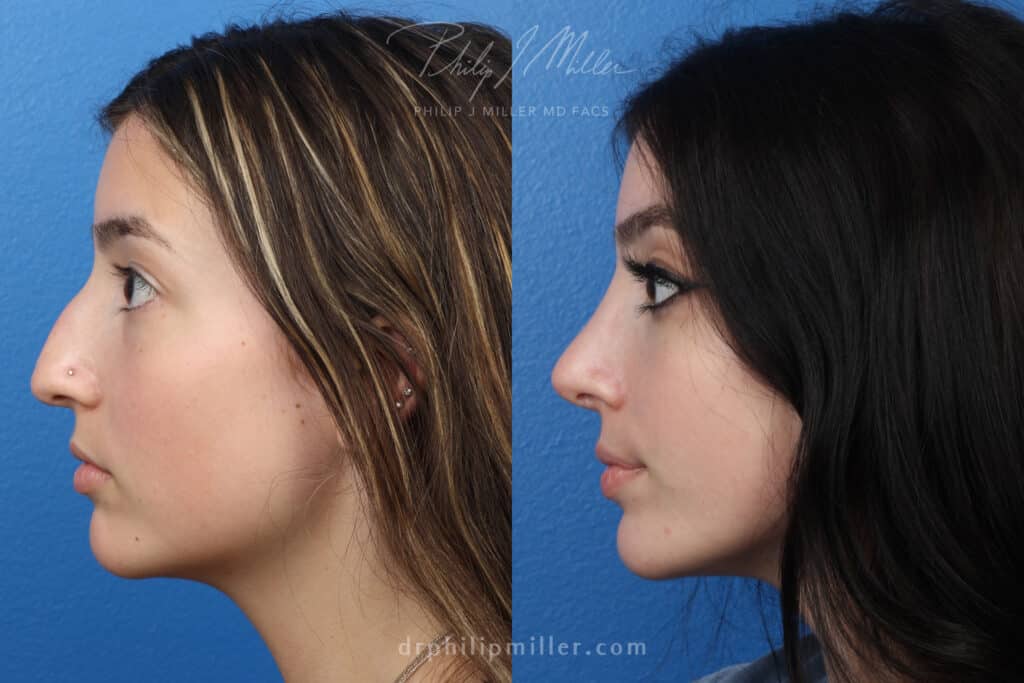
As part of his expertise and distinguished research and training, Dr. Miller uses nose casts to set patients up for success after a surgical rhinoplasty. From pre-operative consultations to post-operative care and questions, he provides patients with unsurpassed care.
Contact us to schedule a consultation and learn more about nose casts after rhinoplasty.
Do I need rhinoplasty or septoplasty?
Noses can have a range of issues that patients want corrected. Septoplasty and rhinoplasty are two common surgical procedures used to correct various nasal abnormalities. Despite being similar in name, the two procedures are actually quite different. A septoplasty focuses on the internal structure of the septum to correct functionality, while a rhinoplasty focuses more on the outer appearance and aesthetics of the nose.
While both procedures are centered around the nose, each method has a designated goal and outcome that can provide patients with a better-looking and functioning nose. Do you need rhinoplasty or septoplasty? Take a look:
Rhinoplasty vs septoplasty: what’s the difference?
Septoplasty is a common procedure to correct breathing problems, and rhinoplasty is used to correct aesthetic features like nose shape and size. Septoplasty is used to correct septal deviations. The septum is the cartilage that separates the nasal passages. When this cartilage shifts to the side, known as a deviated septum, it can affect your ability to breathe easily and lead to nasal blockages and frequent nosebleeds. Septoplasty realigns the septum to achieve symmetry in the nasal cavities and improve nasal function.
A rhinoplasty, also known as a nose job or nose reshaping surgery, is used to improve the appearance of the nose. Many patients feel the shape or size of the nose detracts from other facial features, and a nose job can make minor changes or reconstruct an entire nose to make it fit harmoniously with other facial features. It is a highly complex procedure that can be personalized to fit each patient’s desires and aesthetic beauty goals.
While they have their differences, septoplasty and rhinoplasty are both surgical procedures that require the care and expertise of a board-certified facial plastic surgeon. It is critical to work with a surgeon that has years of experience to ensure your results are seamless and natural.
When to choose rhinoplasty?
Although rhinoplasty is a popular cosmetic procedure, it is not for everyone. You may be a candidate for rhinoplasty if you:
- Are in good overall health
- Want to improve facial balance
- Have an irregularity like a bulbous tip
- Want to address ethnic nose characteristics
A rhinoplasty can address many irregularities, including:
- Size of the nose
- Shape of the nasal tip
- Wide or narrow nostrils
- Angle of the nose
- Nose and upper lip that are too close together
- Hooked or crooked nose
- Hump or bump
- Nose asymmetry
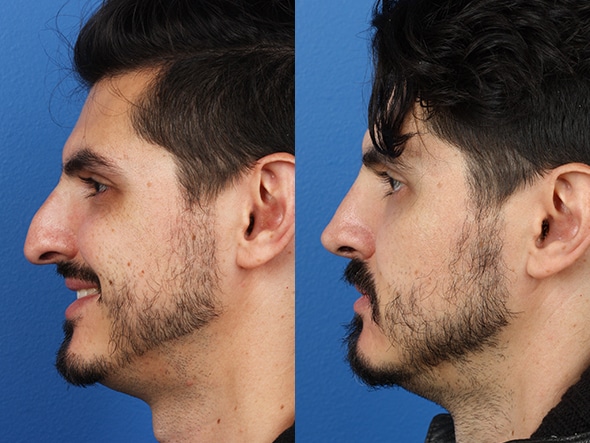
When to choose septoplasty?
You may be a candidate for septoplasty if you experience:
- Excessive snoring
- Sleep apnea
- Recurrent sinusitis
- Breathing difficulties
- Respiratory complaints
- Deviated septum due to injury or trauma
Septoplasty has many benefits associated with clearing the nasal passage, including:
- Uninterrupted breathing patterns
- Better sleep
- Improved airflow
- Self-maintained airways and drainage passageways
- Reduced sinus infections
- Improved smell and taste
Can I get rhinoplasty with septoplasty at the same time?
Yes, rhinoplasty with septoplasty is a common surgical combination. Having rhinoplasty and septoplasty at the same time is a popular choice for patients in need of improved functionality and appearance. It allows you to receive the best of both worlds – the improved breathing offered by septoplasty while adjusting cosmetic irregularities like a hump or bulbous tip. It is safe and effective to correct all issues with one procedure to reduce recovery time and ensure all changes are cohesive.
Your expert facial plastic surgeon should comprehensively evaluate your needs to determine if you need septoplasty and rhinoplasty procedures to achieve your desired results and eliminate any functional issues you might have. There are several benefits to having the procedures done together, such as:
- One surgical cost
- One recovery time
- Convenience
- Possible insurance coverage for the septoplasty portion of the procedure
- Better outcomes aesthetically and functionally
Septoplasty and rhinoplasty surgeon in New York
Philip J. Miller, MD, FACS, is a world-renowned plastic surgeon who is double board-certified in facial plastic and reconstructive surgery of the head and neck. He has more than 20 years of experience with facial plastic surgery and is considered a leading expert in rhinoplasty and facial rejuvenation. He is a highly acclaimed surgeon offering custom treatment plans to help patients meet their aesthetic goals.
Dr. Miller uses the NatraLook® process, an enriching experience that allows patients to explore their confidence in a safe and supportive environment. He creates a unified vision with patients by discussing their personal desires and obstacles. Contact us to schedule a consultation and learn more about septoplasty and rhinoplasty.
Rhinoplasty and Allergies: What You Need to Know
While rhinoplasty cannot cure nasal allergies, it can treat conditions that may exacerbate an allergy, such as nasal polyps, turbinate hypertrophy, or a deviated septum. When a rhinoplasty is combined with a septoplasty, the functional changes made during septoplasty may relieve allergy symptoms and make breathing easier.
Can I Have Rhinoplasty Surgery With Seasonal Allergies?
You can have rhinoplasty surgery even if you have allergies. Allergic rhinitis is not a contraindication to rhinoplasty.
While allergies won’t affect the surgical techniques used in rhinoplasty, symptoms of allergic rhinitis (e.g., runny nose and postnasal drip) can worsen because of post-surgical swelling, possibly making your recovery time more challenging.
Sneezing can also be a challenge during your recovery. Many surgeons advise avoiding sneezing after rhinoplasty during the first week. Because your concern is to reduce nose swelling from allergies and avoid sneezing, it might be best to schedule your rhinoplasty around your allergy season.
If you have a mechanical obstruction in your nose, such as a deviated septum, this may also be improved during your surgery, allowing you to breathe better even in the worst allergy season.
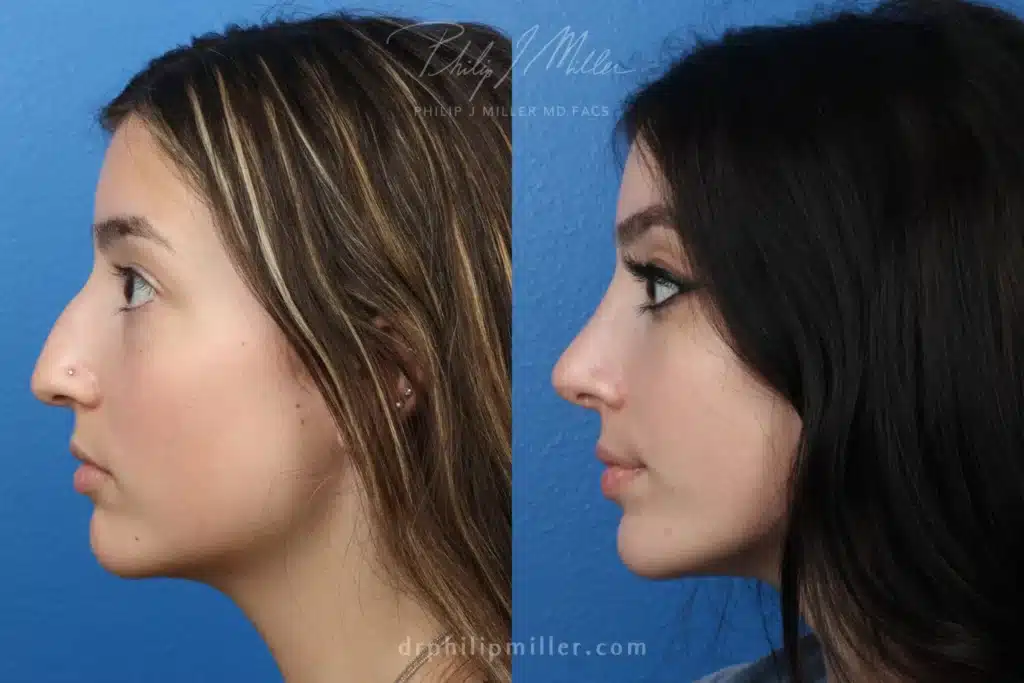
It is best to discuss your allergy history with your surgeon before undergoing nasal surgery. You can work out the right schedule for your surgery, and ideally, your surgeon will enhance the appearance of your nose while correcting any functional issues that affect your breathing.
How Rhinoplasty Can Help with Seasonal Allergies
Septoplasty, also referred to as corrective rhinoplasty, is a surgical solution for a deviated septum. If you have a deviated septum and seasonal allergies, straightening the septum can significantly ease your discomfort during allergy season.
Deviated septum and allergies often go together. While a deviated septum does not cause allergies, it can exacerbate the severity of allergy symptoms like congestion and sneezing.
Turbinates act like the tonsils of your nose. They are projected structures that help filter and humidify the air you breathe. They can become swollen when allergies flare up.
Turbinate reduction surgery can be performed as part of a rhinoplasty. By reducing the size of your turbinates, you experience less congestion and have an easier time breathing even with allergies.
Nasal polyps are small spherical growths that appear along the nasal passages, often as a result of the inflammation caused by allergies. Seasonal allergies may cause small nasal polyps to form. Large polyps can worsen allergy symptoms and affect airflow.
Polyps can be fixed during rhinoplasty to reduce congestion and improve breathing –both providing relief from your seasonal allergies.
Can a Nose Job Treat My Allergies?
No surgery is available to treat nasal allergies. Allergies are caused by immune responses to allergens (e.g., dust, pollen, and smoke) and not structural problems of the nose.
However, rhinoplasty can address conditions that worsen the symptoms of allergies, such as nasal polyps, turbinate hypertrophy, or a deviated septum. While these conditions aren’t responsible for the allergies themselves, they can make it more difficult to breathe when allergies strike.
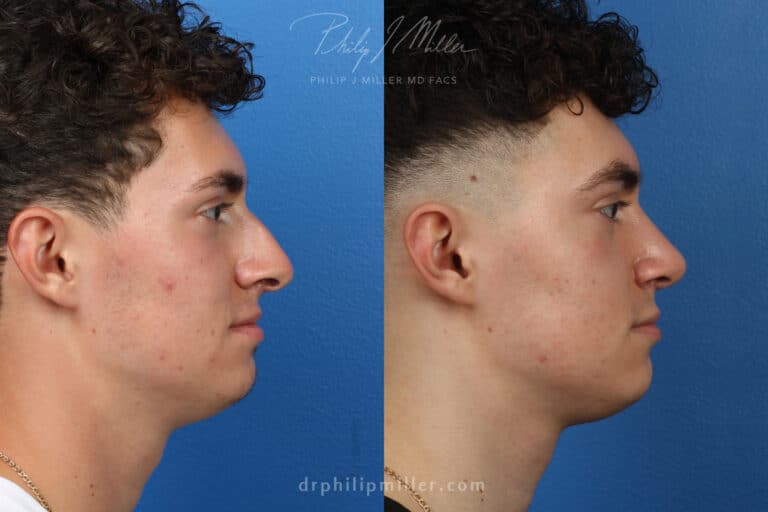
Learn more about allergies at the Mayo Clinic.
Septoplasty vs. Rhinoplasty for Allergies
Rhinoplasty and septoplasty can improve the function of your nose so you can breathe easier. While a septoplasty is focused on fixing a deviated septum and addressing functional issues, a rhinoplasty will also improve the aesthetic appearance of your nose.
Deciding which nose allergy surgery is best should depend on your specific concerns and goals. Consulting with your surgeon is crucial. Your surgeon will ask about your medical history, allergy history, and medications, as well as the cosmetic and functional goals you want to achieve. Your surgeon can then recommend the best surgical approach for your unique case.
Getting Nasal Surgery for Allergies in New York City
Double-board certified facial plastic surgeon, Philip J. Miller, MD, FACS, blends art and science with innovation and skill to provide thousands of patients with impeccable results. Considered one of the country’s leading experts in rhinoplasty and facial rejuvenation, Dr. Miller and his highly acclaimed team are proud to offer patients the highest level of care and customized treatments in New York City.
Dr. Miller developed the NatraLook methodology for his cosmetic procedures for the face. NatraLook is a specialized consultation process through which Dr. Miller will evaluate your facial features and listen to your concerns and goals. He will reassure and support your opinions positively, creating a collaborative environment that gives you a real say in your own procedure. This opportunity allows patients and Dr. Miller to create a unified vision for optimal results and the most natural outcome possible.
If you’re considering nose surgery for allergies, other functional concerns, or cosmetic reasons, schedule a consultation with Dr. Miller in Manhattan, New York, or New Orleans, Louisiana today.
Next, read more about nose surgery for breathing here.
When to Choose a Nose Tip Surgery Over Full Rhinoplasty?
Sometimes the aesthetic improvements you’re looking for can be achieved with nose tip surgery rather than a full rhinoplasty. If your concerns are centered around the appearance of the tip, nasal tip refinement may be sufficient for you. If you’re looking for a more dramatic result that involves other parts of the nose, a full rhinoplasty may be a better choice.
A nose tip job can effectively address a number of issues to elevate your aesthetic appeal and improve your self-esteem. Before your consultation, check out these common aesthetic concerns to help you determine whether rhinoplasty tip refinement is the right choice for you.
Droopy Tip
A droopy tip can appear just when you smile or it may be apparent all the time. It can be a genetic trait or the result of a previous rhinoplasty. This cosmetic concern can be altered with a nasal tip rotation surgery that focuses exclusively on lifting and refining the nose tip.
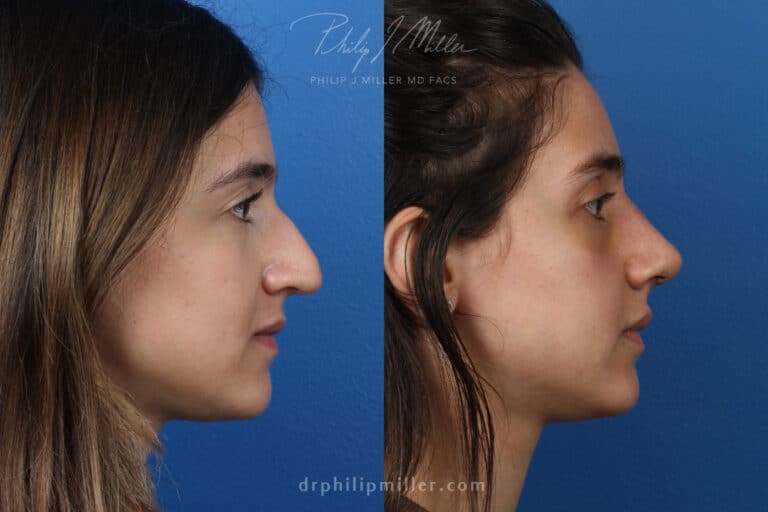


This procedure internally points the tip of the nose upwards, increasing the angle between the upper lip and the bottom edge of the nose. This gets rid of the “droopy” appearance.
There are a variety of ways that Dr. Miller can effectively address a droopy tip. These can include trimming excess cartilage, shortening the nasal septum, or reducing the length of the lateral cartilage. Sutures can be used on lower lateral cartilage to lift the tip, or a graft could be used to increase nasal tip support.
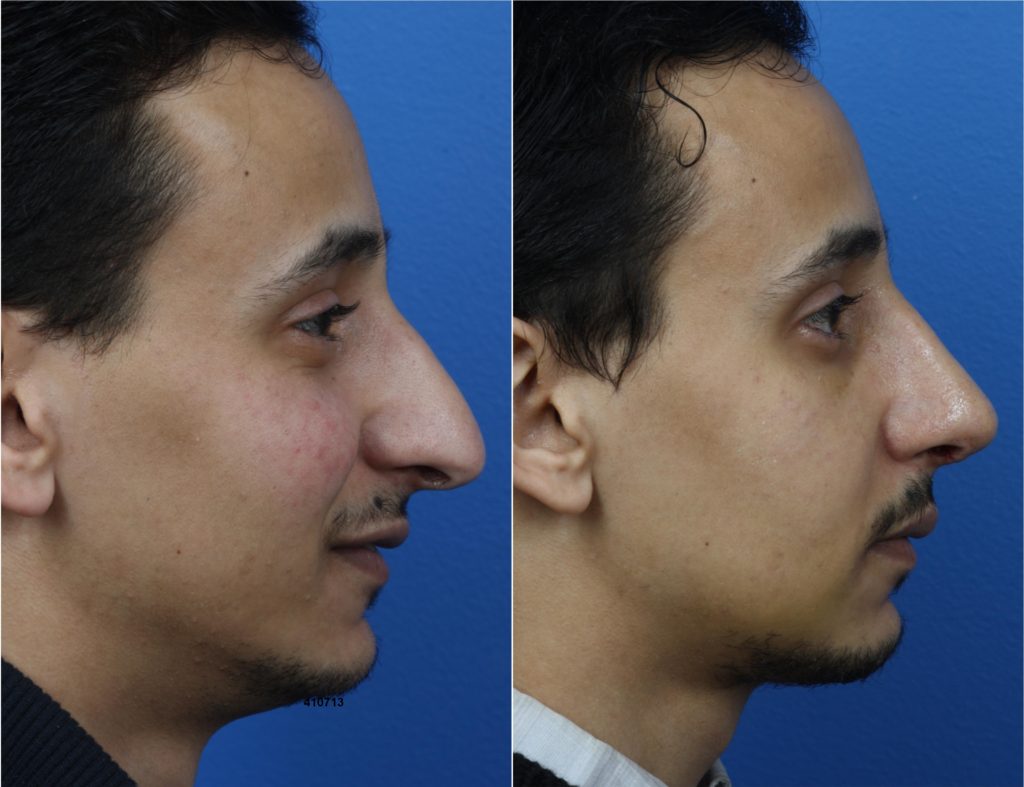
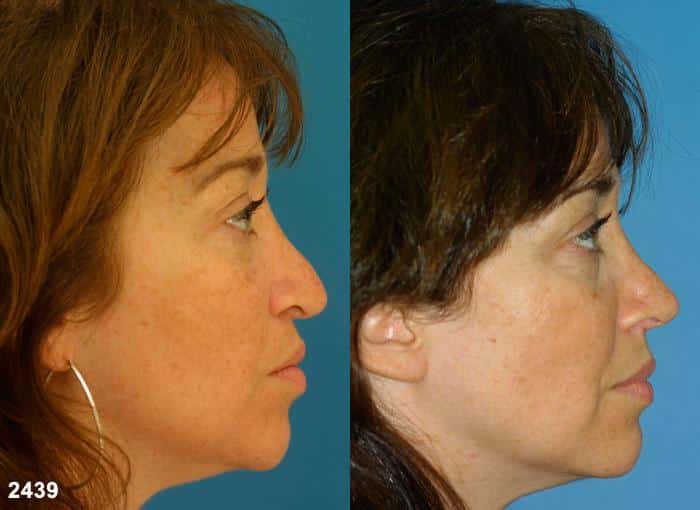
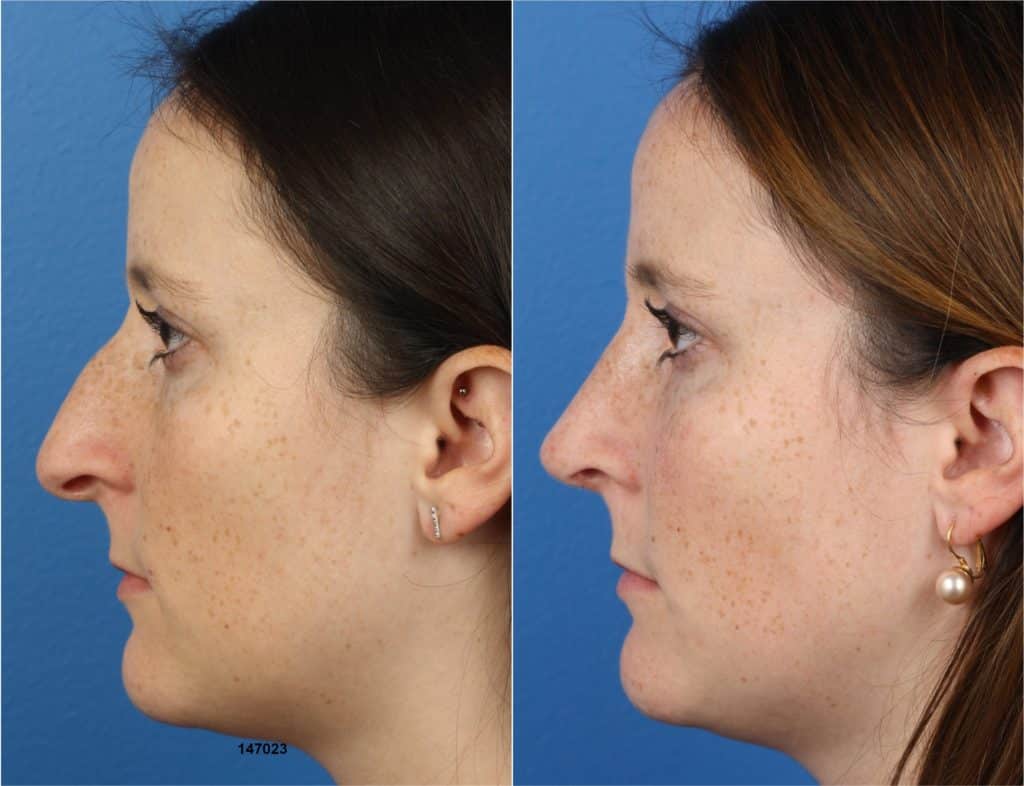
Upturned Tip
An upturned tip requires the opposite of the fix for a droopy nose. A nose derotation procedure lowers the upturned tip, decreasing the angle between the upper lip and the bottom edge of the nose. A tip refinement rhinoplasty can often address this issue without the need for a full rhinoplasty.
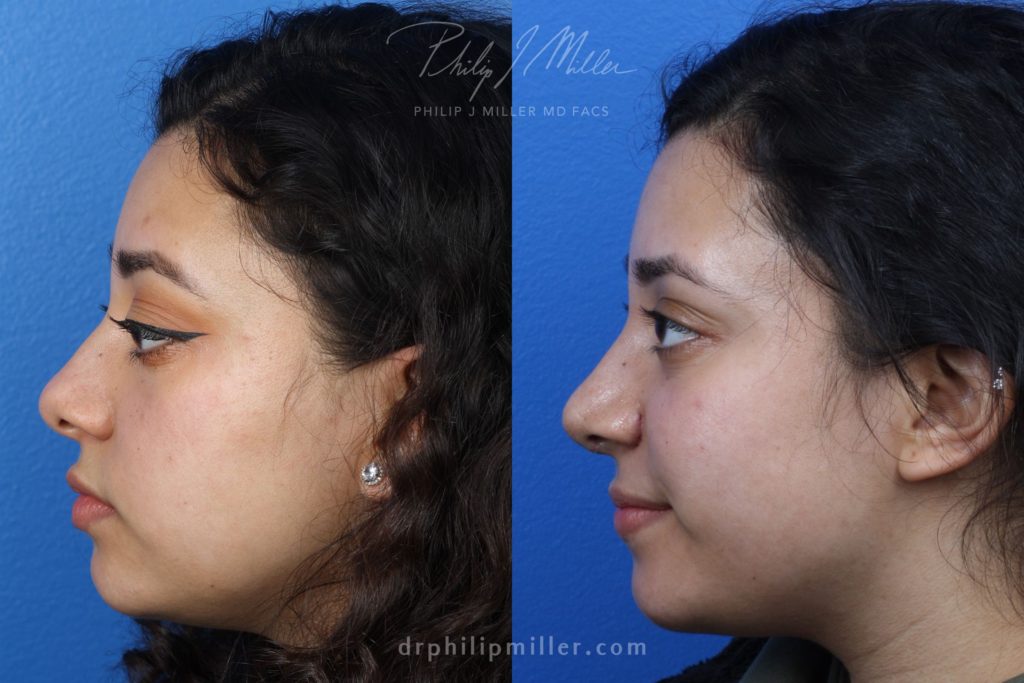

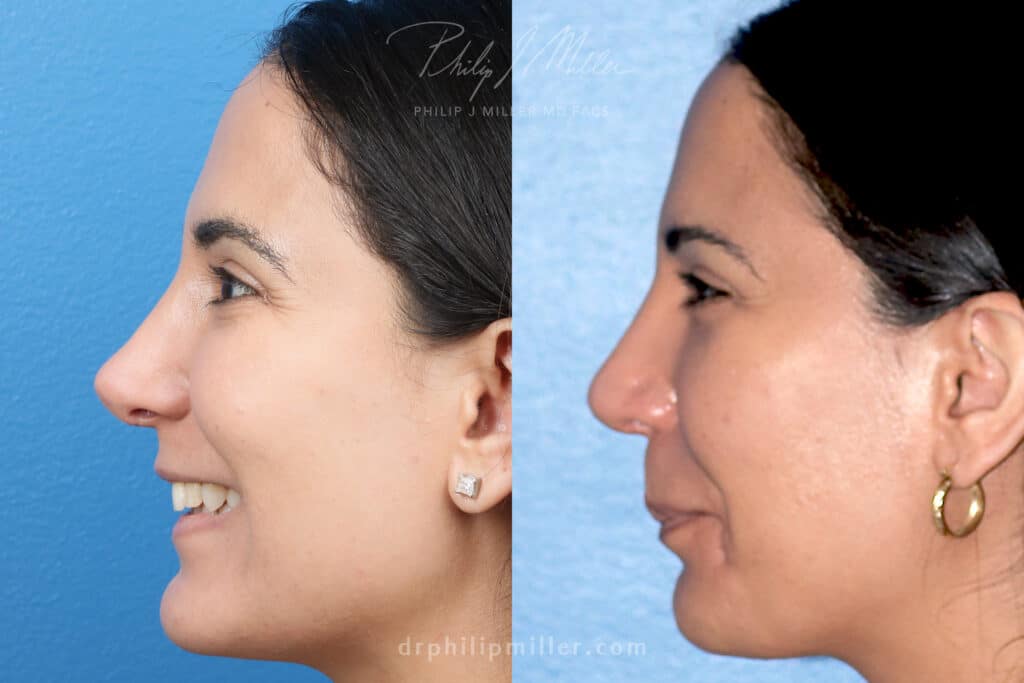
Bulbous Tip
A bulbous tip appears round, like a bulb on the end of the nose. Making this shape less circular and more pointed involves nose tip refinement. By altering the cartilage or using sutures to pull the nasal structure forward, Dr. Miller can resolve a bulbous tip and create a more aesthetically pleasing profile.
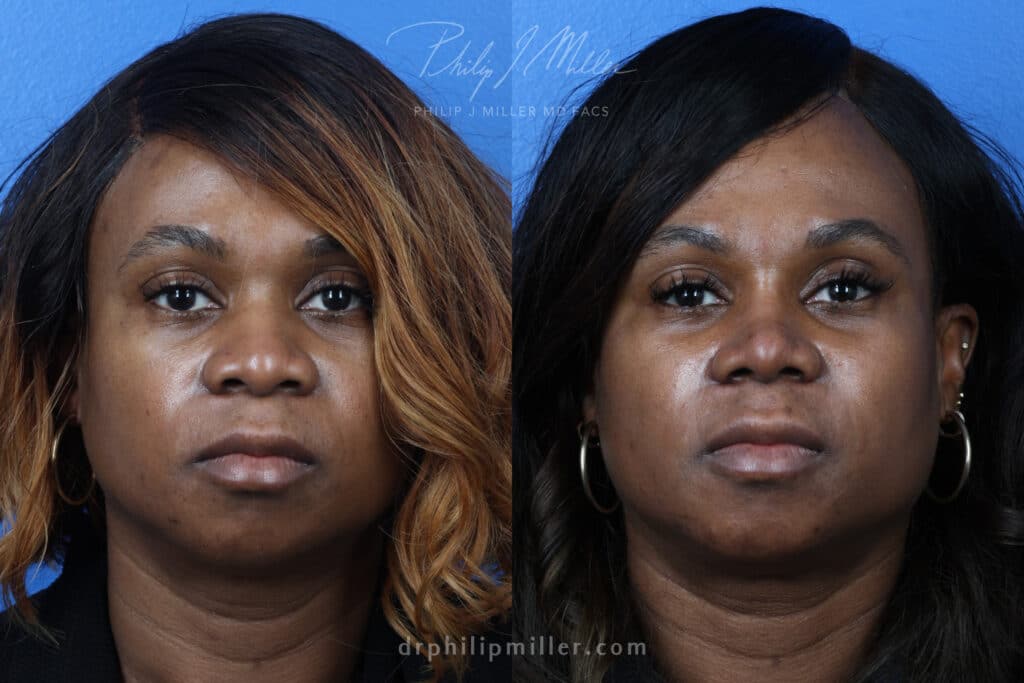
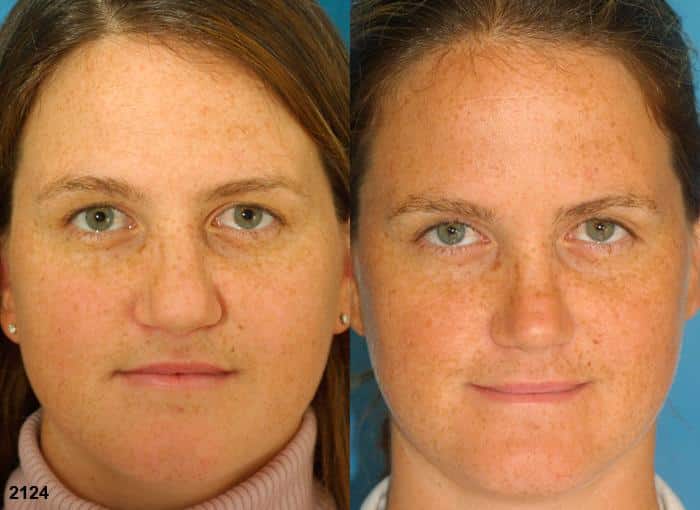
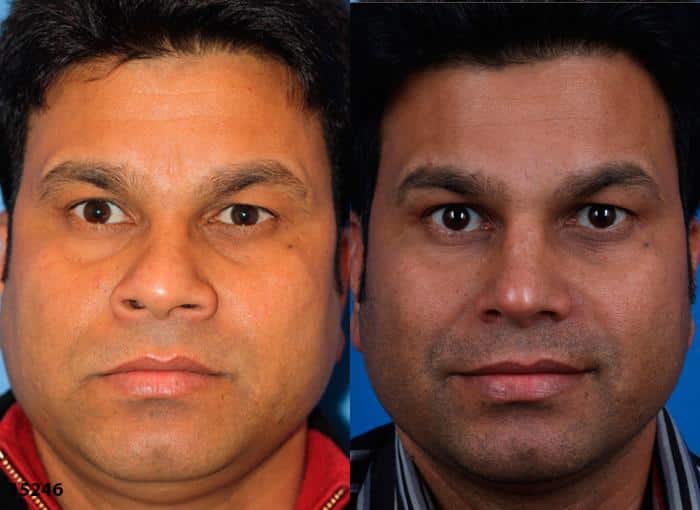
Overprojected Tip
An over-projected tip extends out farther than the average nose. Dr. Miller can effectively reduce the overall size of the nose to bring it into proportion with the rest of the facial features. To refine the tip of the nose, Dr. Miller may remove cartilage from the area. This creates a smaller projection that matches the visual goals of the patient. A full rhinoplasty may also be required to adjust the nasal bridge as well as the tip.
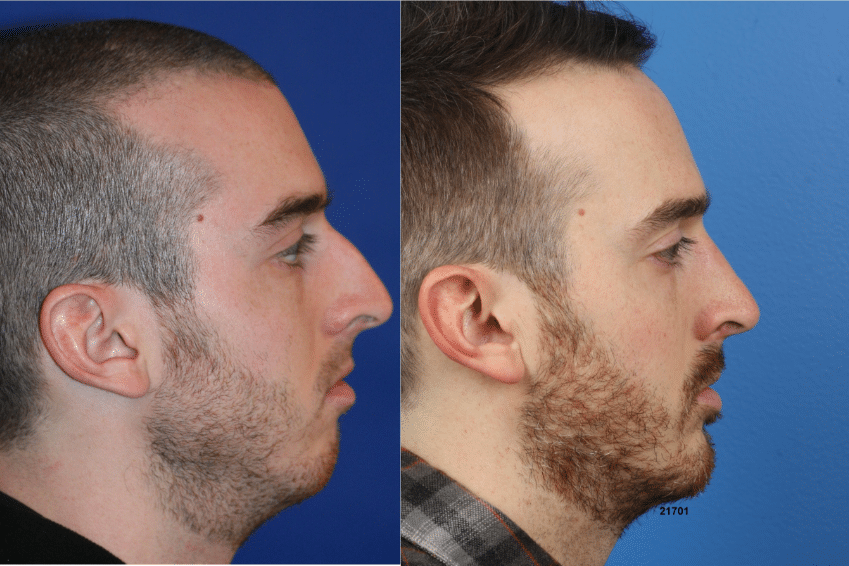
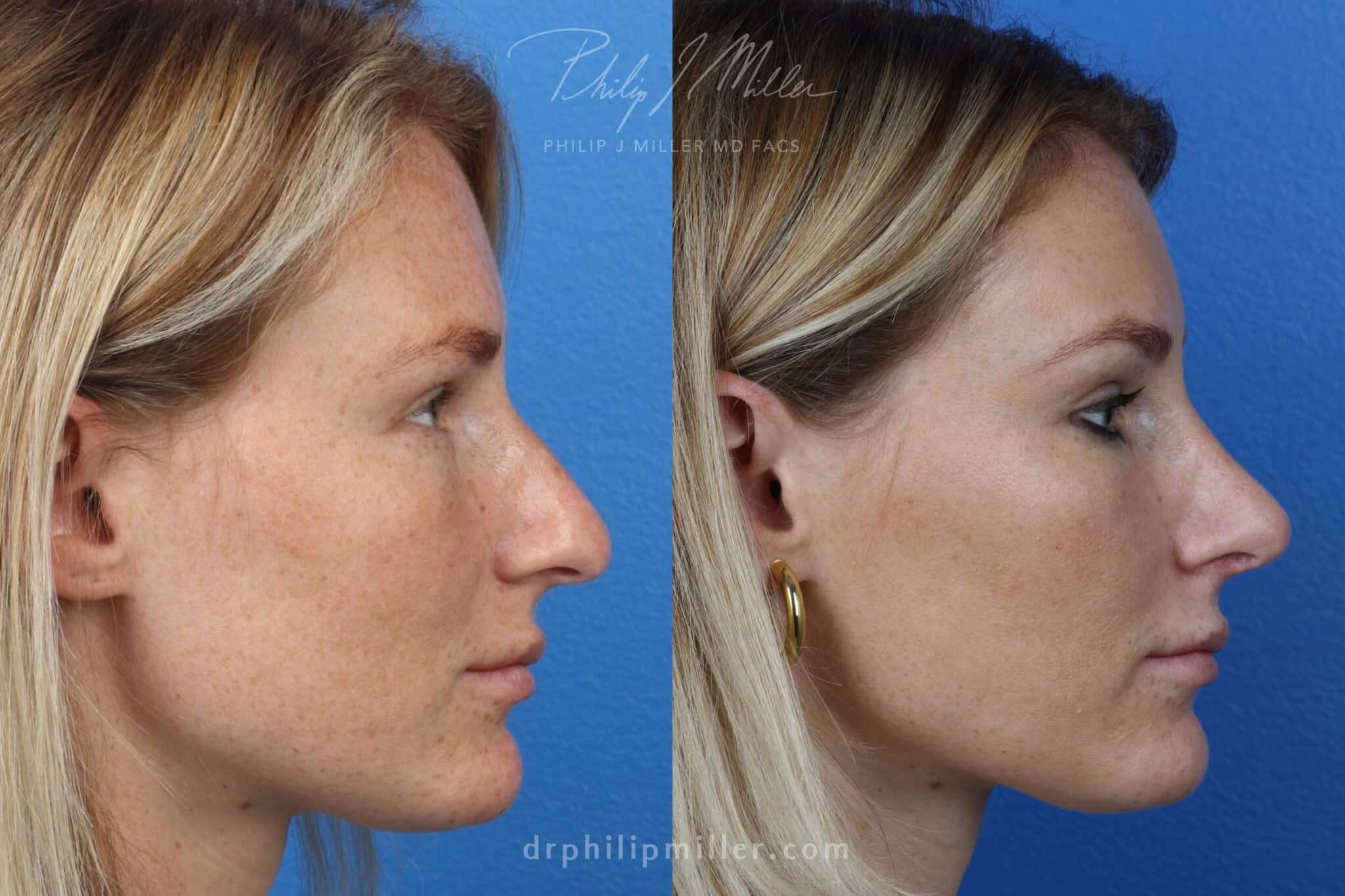
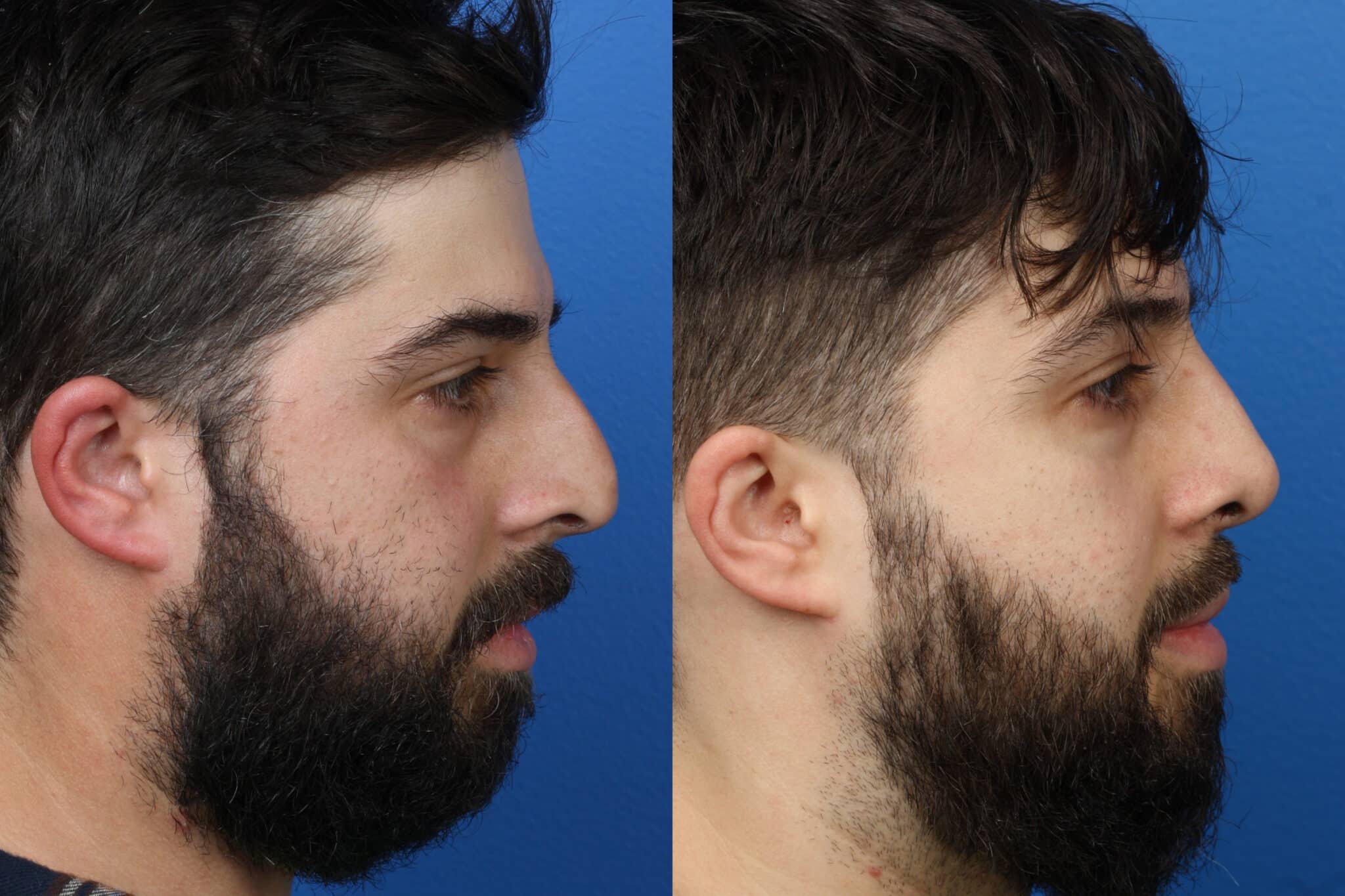
Wide Nostrils
Wide nostrils can create a broader base to the nose that may look out of proportion with the other facial features. Dr. Miller can effectively reduce the lower lateral cartilage to create smaller nostrils, and pull them forward to produce a better aesthetic. If you’re dealing with wide nostrils, rhinoplasty for tip refinement may be a great choice for you. If you have wide nostrils and other nasal structure issues that you’d like to have addressed, a full rhinoplasty would be a better option.
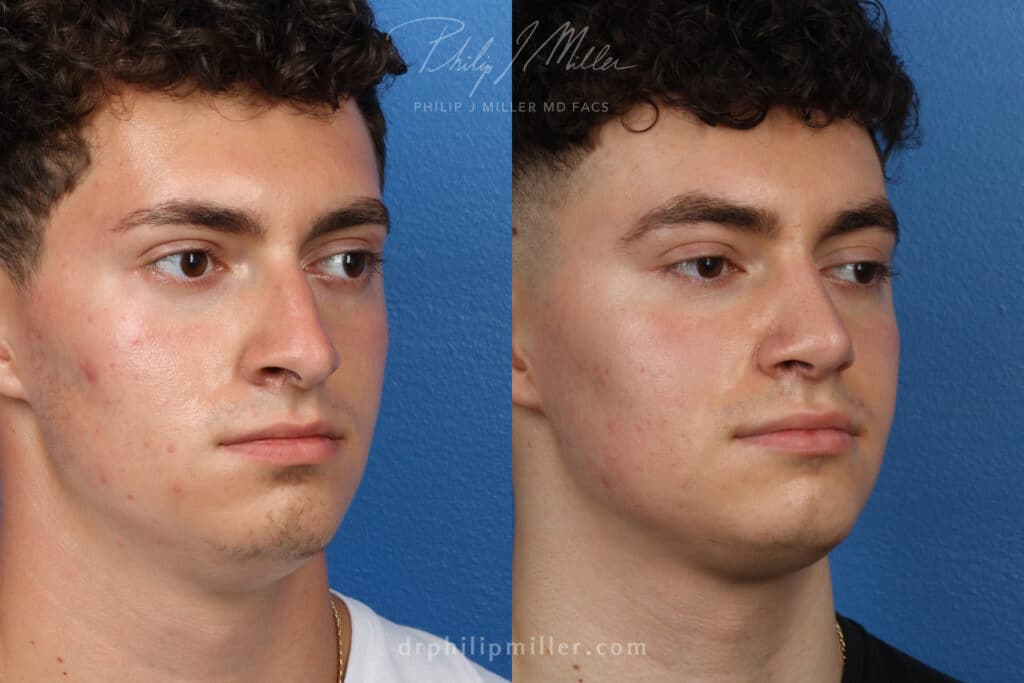
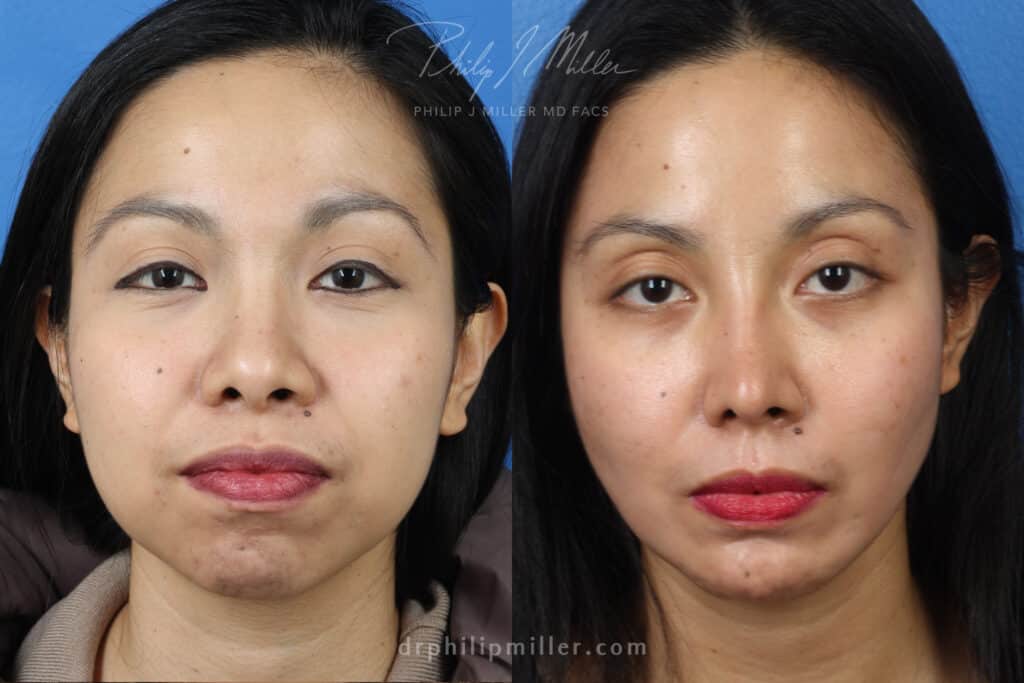
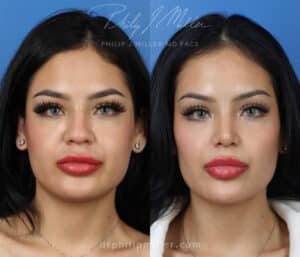
Benefits of Nose Tip Surgery
There are some benefits to choosing a refined tip rhinoplasty over a full rhinoplasty:
- Recovery time may be quicker
- Less bruising and swelling after surgery
- Tip of nose rhinoplasty might cost less
- Results last as long as full rhinoplasty
- Very satisfying results for the right patient
A nasal tip rhinoplasty may not be the right choice if you want correction to your nasal bridge or you have structural issues that impact your breathing. A consultation with an experienced rhinoplasty surgeon will help you determine the best approach for you.
Getting Nasal Tip Surgery in New York City
Philip J. Miller, MD, FACS, is a double-board certified facial plastic surgeon who has a wealth of experience and expertise in all types of rhinoplasty techniques. He will customize your surgery to ensure a harmonious, beautiful, and natural result.
Dr. Miller’s proprietary Natralook consultation process helps you achieve aesthetic confidence in a safe environment. By understanding your goals and discussing your needs, Dr. Miller can align your results with your expectations for a positive experience and outcome.
Contact his office in Manhattan, New York, or New Orleans, Louisiana, to schedule your consultation with him today.
8 Nose Imperfections People Correct with Rhinoplasty
No one’s face is perfect, but some people may have noses that can be a significant source of self-consciousness and low self-esteem. Nose surgery, also called rhinoplasty, can be performed on the nose to correct nasal imperfections and asymmetry.
Nose imperfections are common, which is why rhinoplasty procedures are one of the most popular cosmetic surgeries in the world. Take a look at these eight nose imperfections that can be corrected with rhinoplasty:
Dorsal Hump
A dorsal hump is a cartilage or bone irregularity on the nose that causes a hump in the outline instead of a seamless slope from the bridge to the tip. They do not cause health problems but can lead to dissatisfaction with one’s appearance. The dorsum bone and cartilage connect the nose to the face and is often called the bridge. Rhinoplasty can remove the hump to produce a more aesthetically-pleasing facial profile.
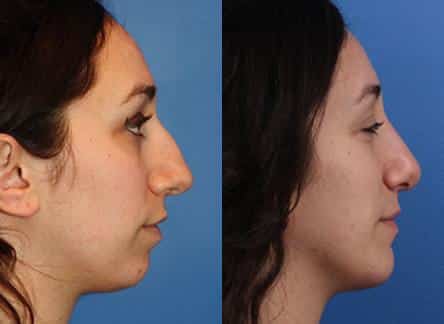
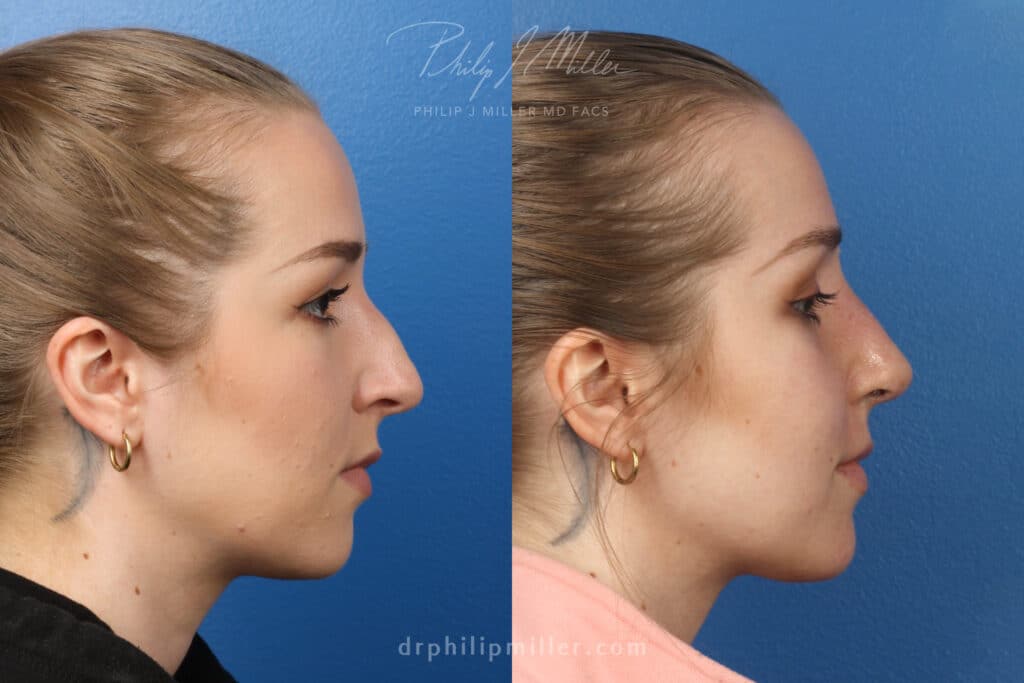
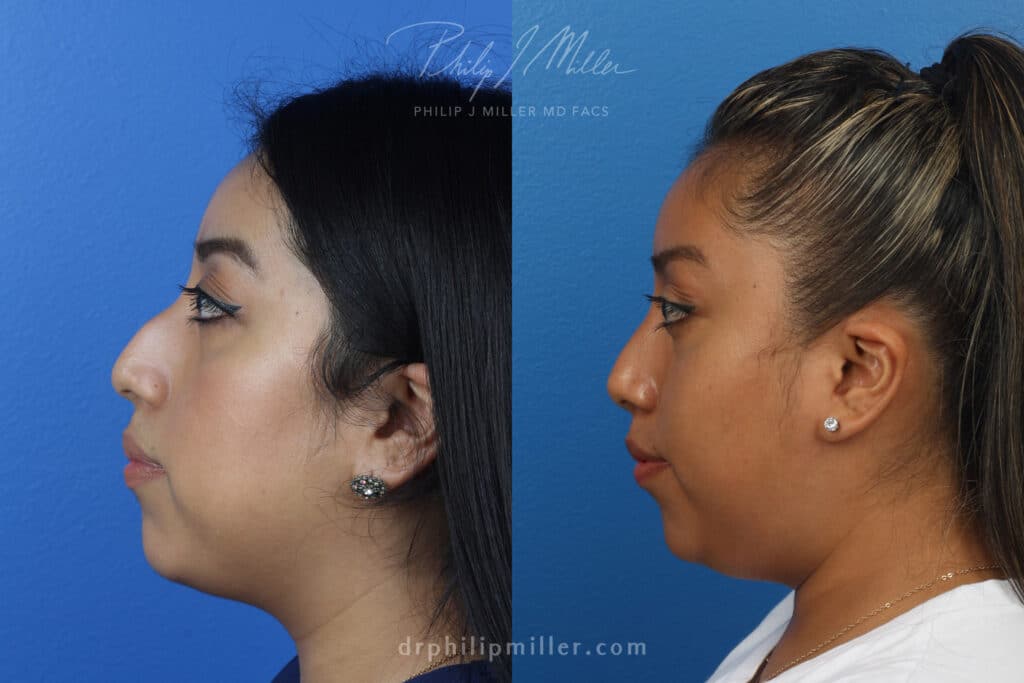
Philip J. Miller, MD, FACS, can also use his microrhinoplasty technique to correct unsightly humps without fracturing bones or using other more invasive approaches. It is an innovative procedure that utilizes an air-powered microrasp with local anesthesia. Using a small incision in the nostril, the specialized device removed the obtrusive layer with extreme precision for a contoured look. Patients experience minimal side effects like swelling and bruising and can return to normal activities within several days.
Wide Nose Bridge
The bridge of the nose extends from the top of the nose, below the eyes, to the tip of the nose and is used to help direct airflow to the nasal passages. In addition to its functional role, the nasal bridge is also considered an important feature of the face that can add to a person’s overall facial appearance and balance.
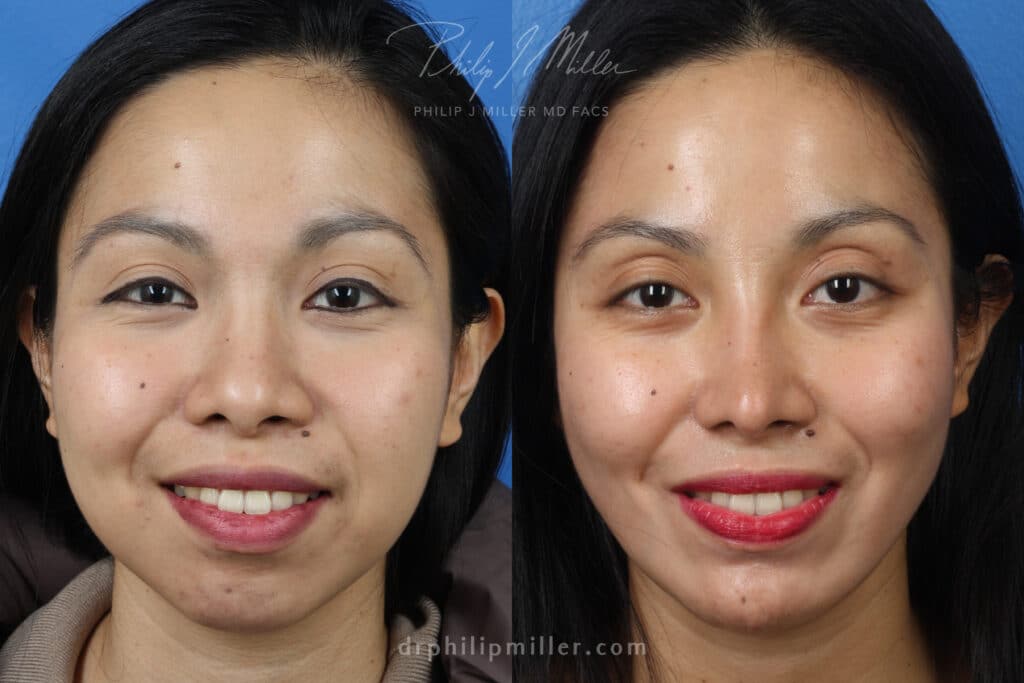

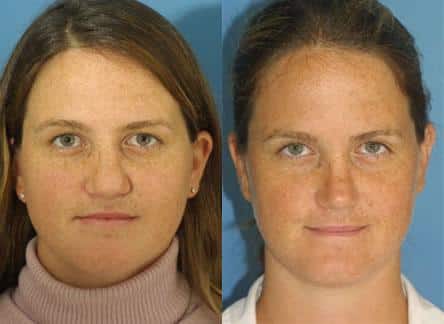
A wide nasal bridge is often common among many Asian, African, and Hispanic ethnicities. It is important to work with a board-certified facial plastic surgeon with experience in ethnic rhinoplasty procedures to ensure beautiful natural results that do not compromise your heritage in these situations. A wide nose bridge can be corrected with a specific technique during a rhinoplasty called an osteotomy, which narrows down a wide nasal bone for a more proportionate look.
Low Nasal Bridge
A low nasal bridge occurs when the bridge is flat and doesn’t protrude. It is a common characteristic among many ethnicities, such as Asian and African patients. A low nasal bridge doesn’t typically cause breathing problems but can be a cosmetic concern. The nasal bridge can be reshaped with a rhinoplasty to create a straighter profile and a more harmonious face shape.
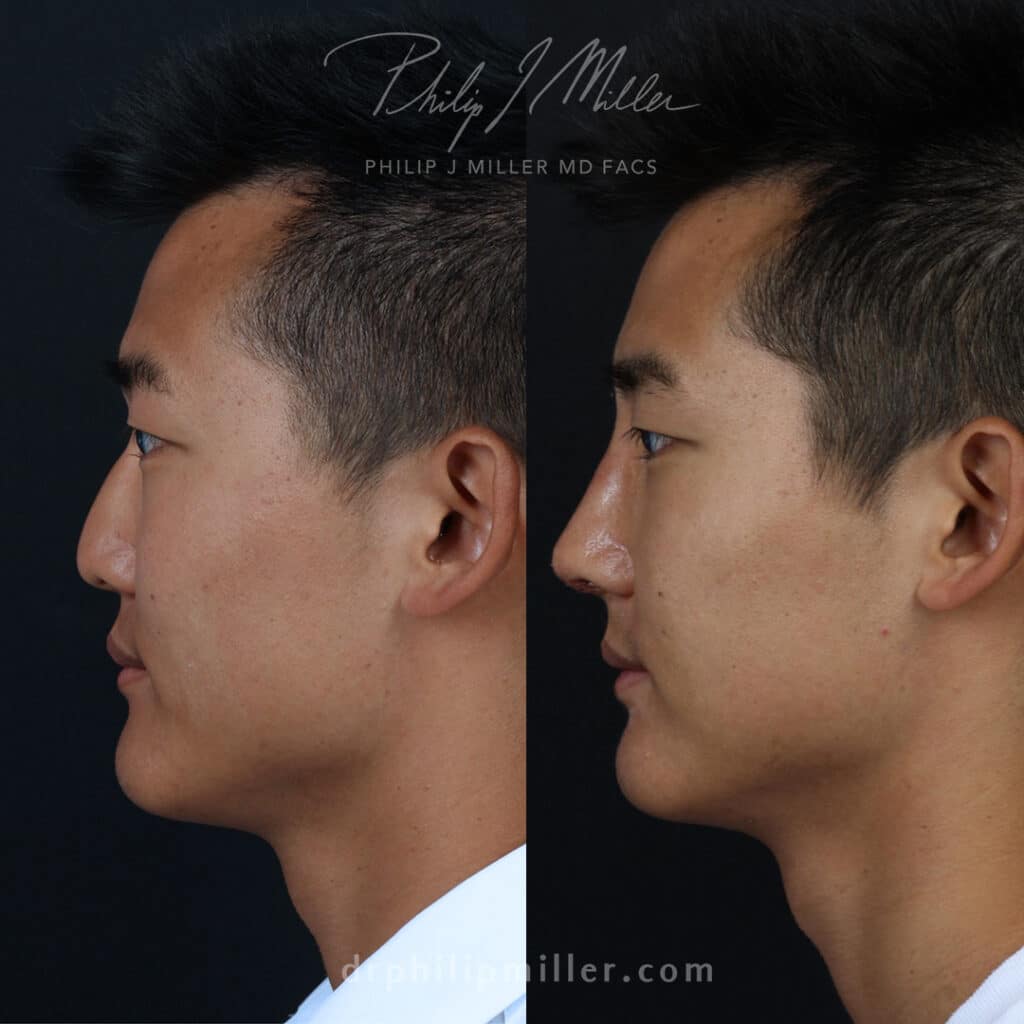
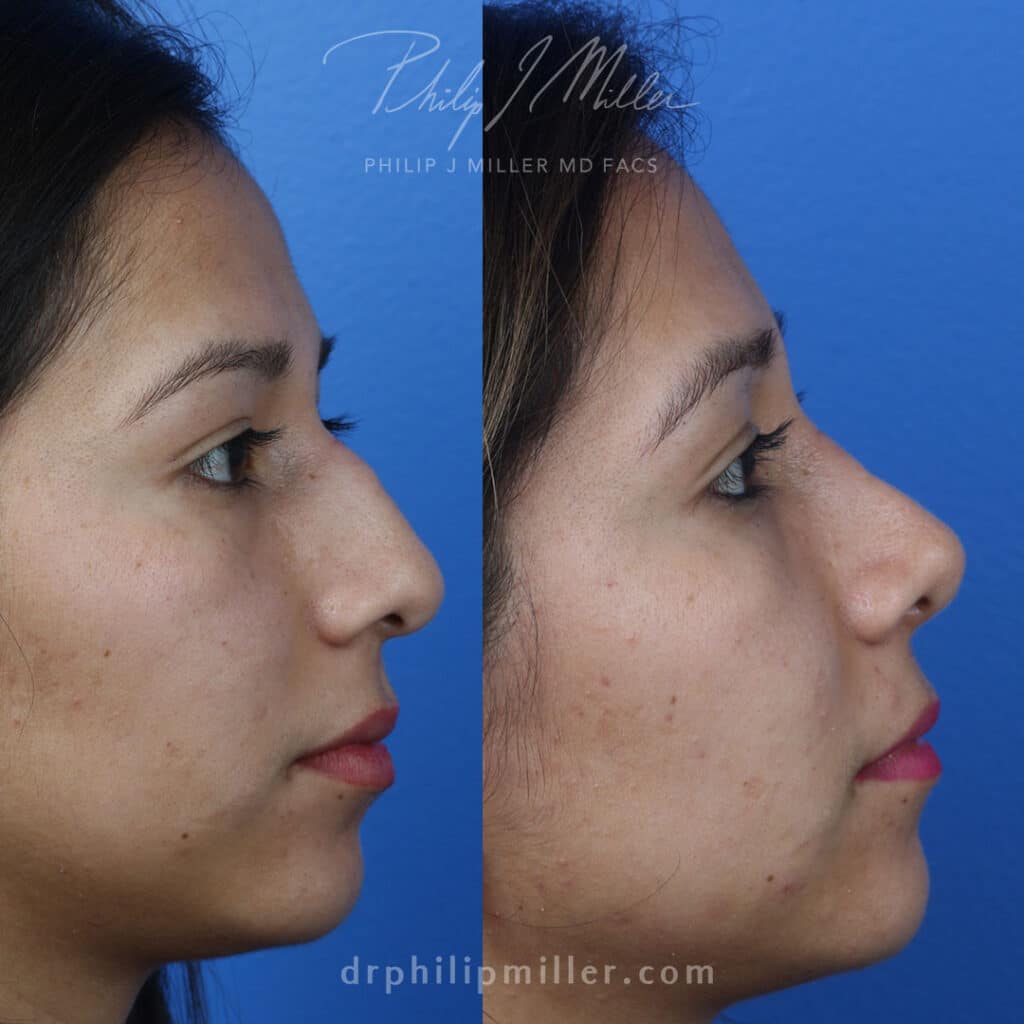
Bulbous Tip
A bulbous tip is wide and round and can also be called a ball tip nose. The bulb-like shape of the nasal tip is typically due to excess cartilage or cartilage without definition. A bulbous tip can also be due to thick nasal tip skin, which is often seen in ethnic noses. During nose tip surgery, the edges of the cartilage are trimmed to create a more refined nasal tip.

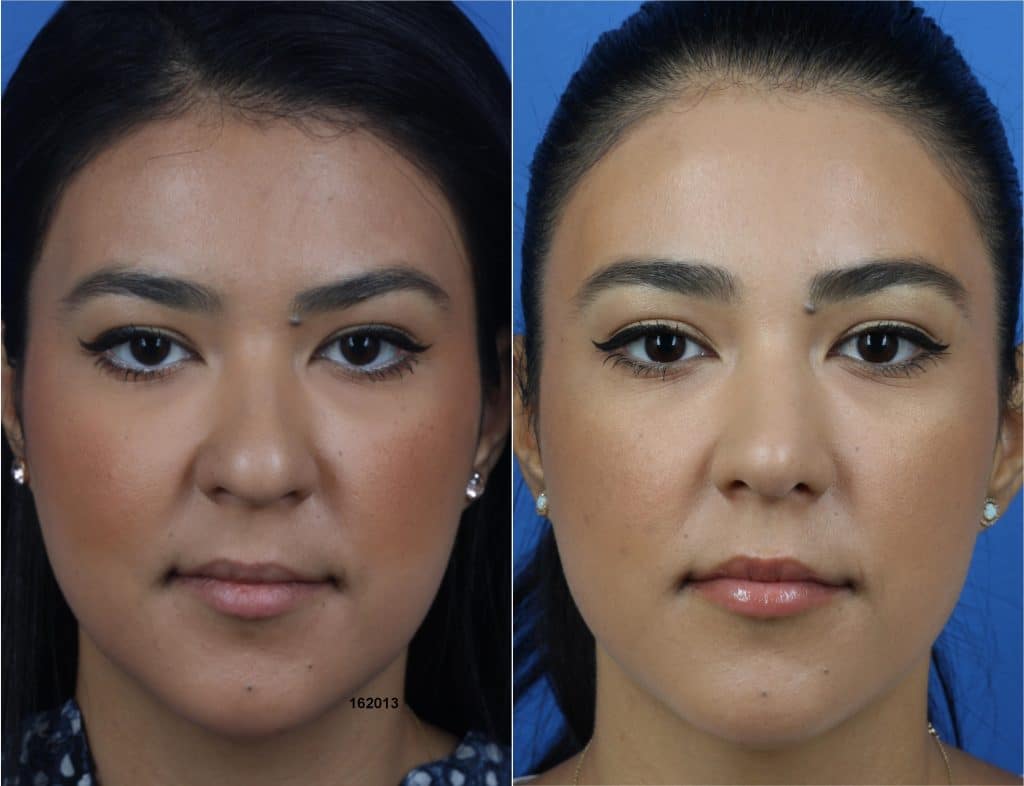
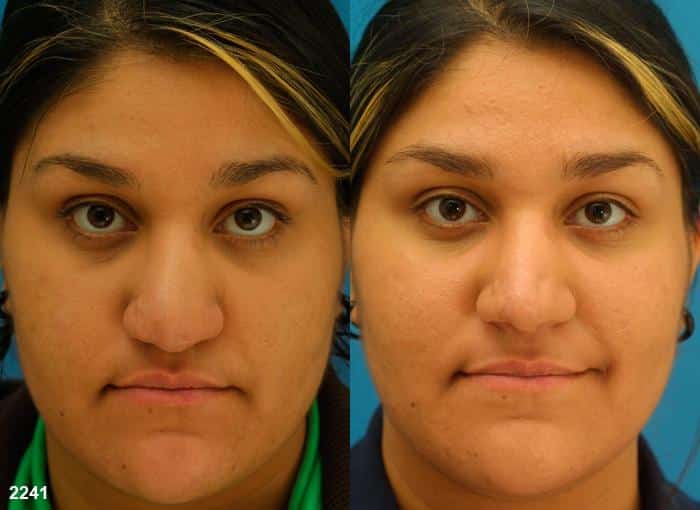
Drooping Nose Tip
A drooping nose tip is characterized by a downward slope that can sometimes result in an unnatural appearance, nasal blockage, and breathing issues. The drooping tip can form due to excess cartilage around the nose, aging, and skin laxity. Rhinoplasty is a permanent solution that can remove excess cartilage and provide support for the nasal tip, lifting and refining the nose for a more pleasing profile.
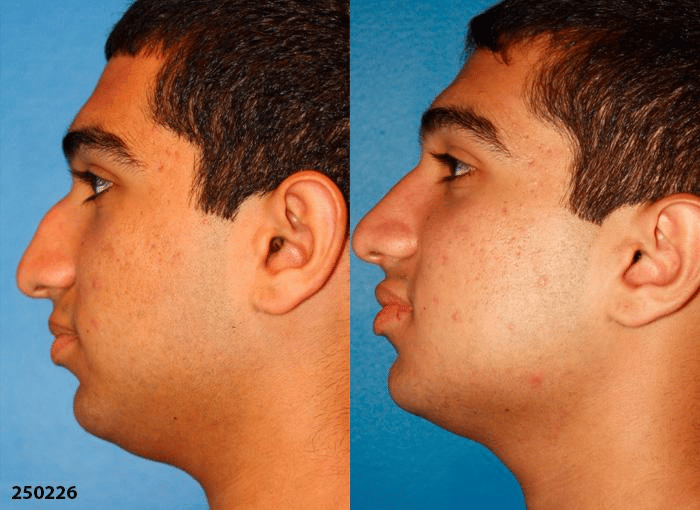
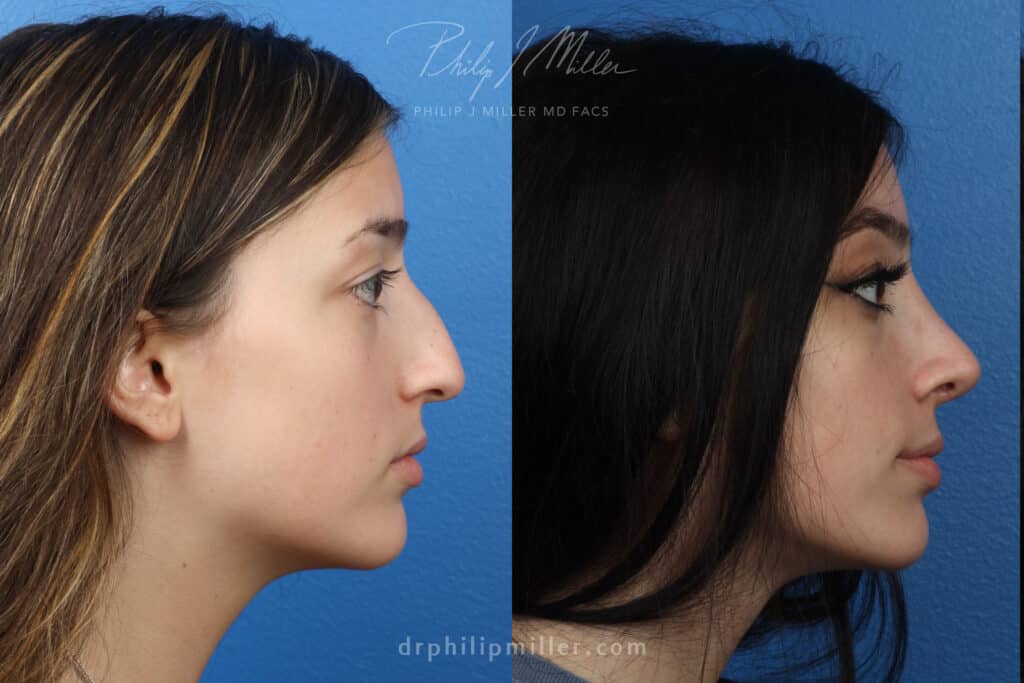
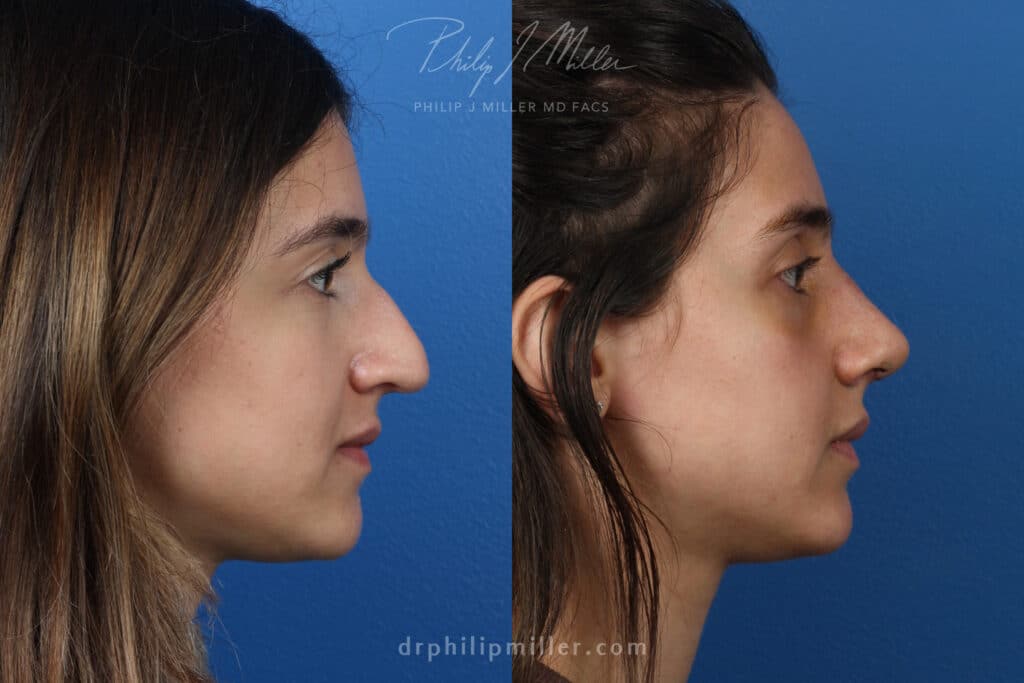
Droopy Nose when Smiling
Many patients have concerns about a droopy nose when they smile. A droopy nose when smiling can form from a weak structural base and droopy tip. The muscles around the nose move to make the tip appear droopy with wide nostrils making the problems more exaggerated during the facial expression. An expert surgeon can correct this concern and in some cases, temporary non-surgical treatments like Botox injections can also improve the droopiness.
Wide Nasal Base
A wide nasal base features a broad spread at the base of the nose, which can include enlarged nostrils that are disproportionate to the rest of the nose. In this case, a nose reduction procedure known as alar reduction can focus on narrowing the base of the nose by making the nostrils smaller, removing excess cartilage, and refining the nasal tip. Some ethnicities naturally have a wider nasal base that can be corrected by a facial plastic surgeon with expertise in ethnic rhinoplasty techniques.
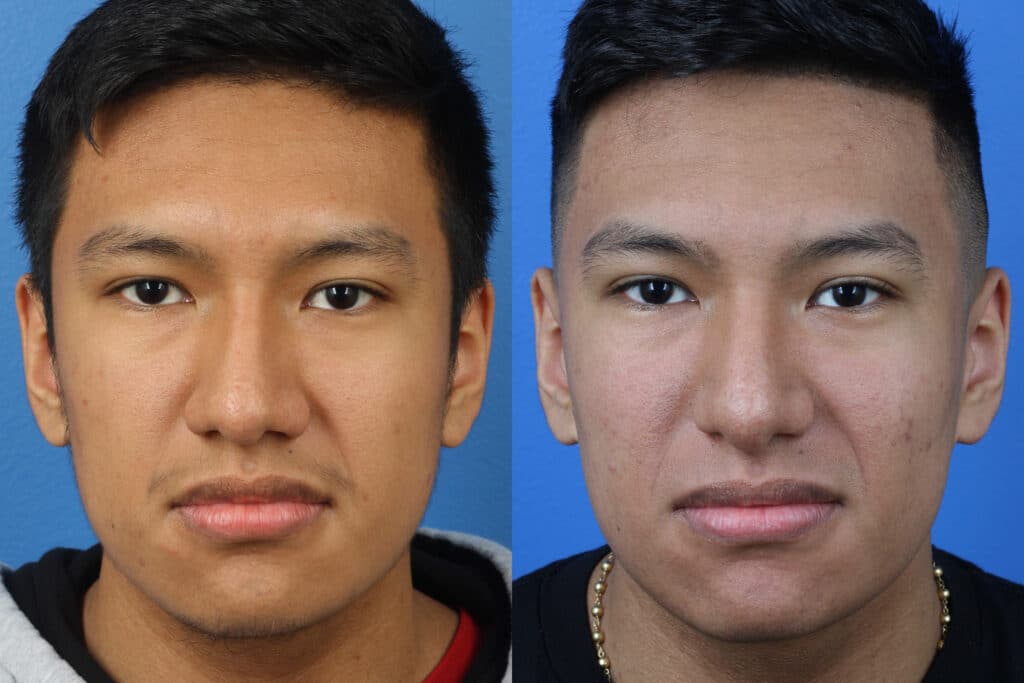
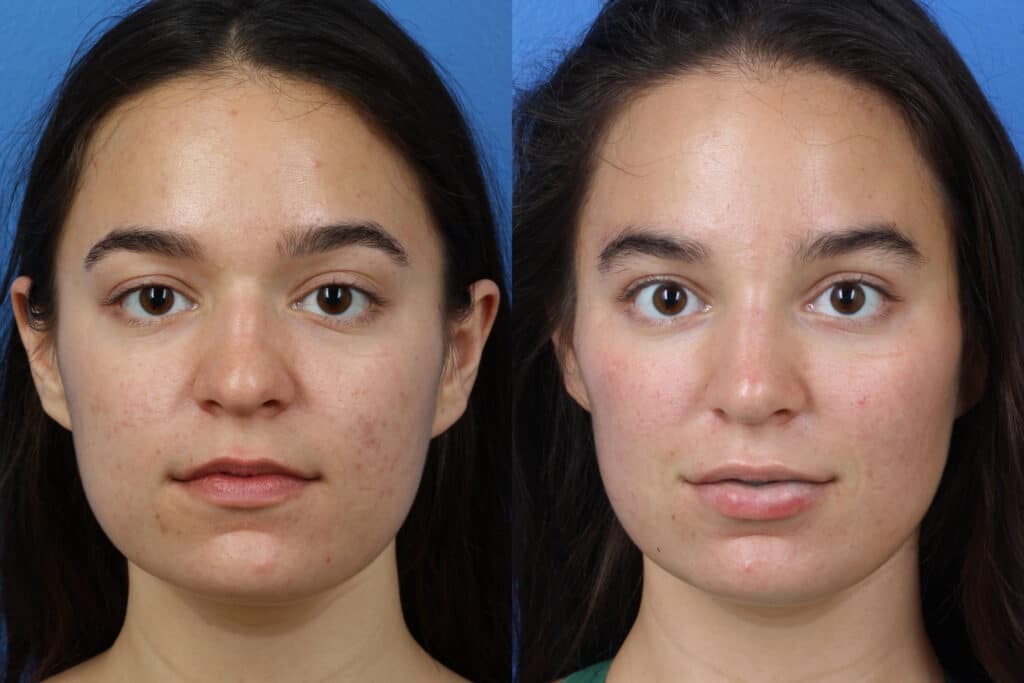
Hanging Columella
The columella is the tissue that separates the nostrils at the base of the nose. A hanging columella occurs when the connective structure drops lower than the base of the nose so it can be seen in the profile. Some patients are born with this feature, while others can have a long septum that pushes the columella downward. A hanging columella can be corrected with a rhinoplasty procedure and can be altered without reshaping any other portion of the nose.
Learn more about rhinoplasty here.
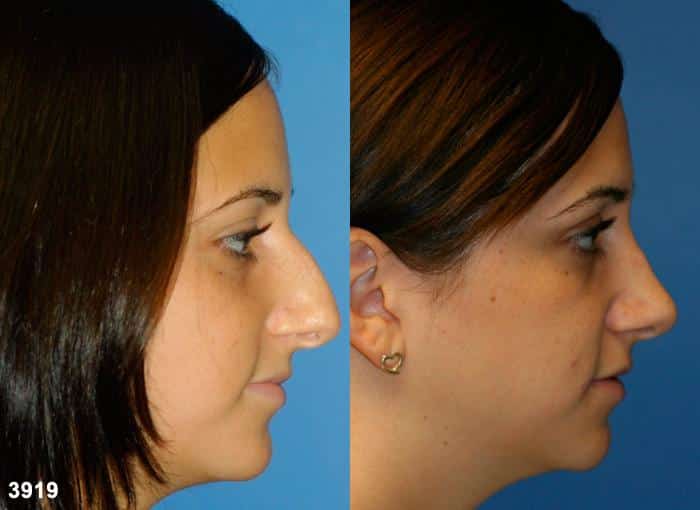
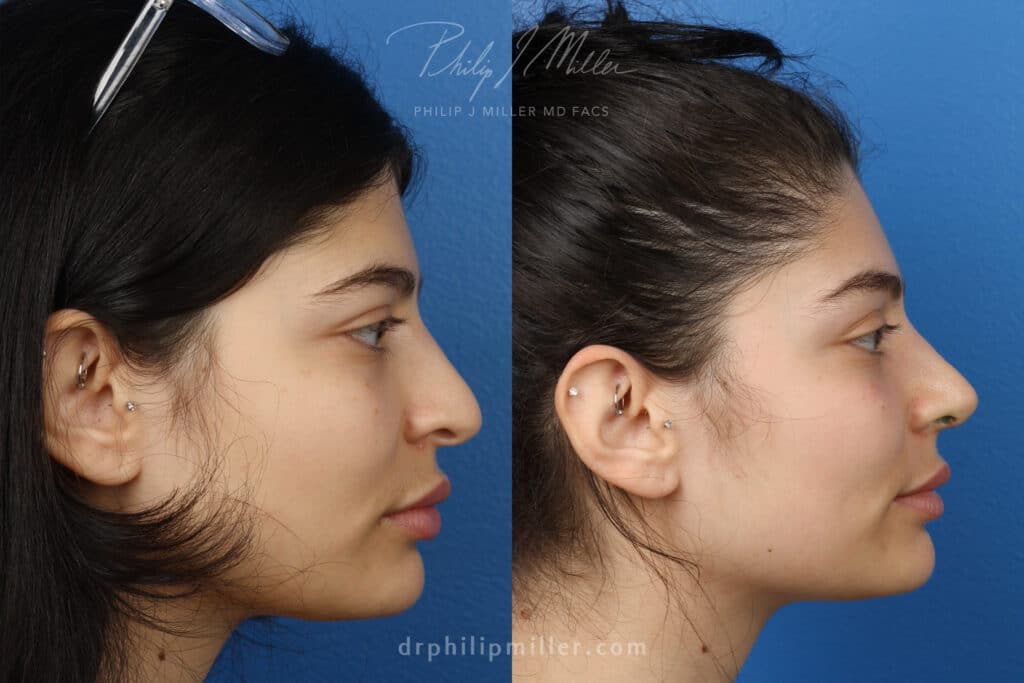
Concerns with Your Nose? Dr. Miller can Help
Dr. Philip Miller is a double board-certified facial plastic surgeon with more than two decades of experience in facial procedures including rhinoplasty. He provides a supportive environment for patients to explore their aesthetic beauty with his proprietary Natralook® process. Contact us to schedule a consultation and learn more about how rhinoplasty can change your appearance for the better.
Nose Surgery for Breathing
If you’re having trouble breathing due to a deviated septum or experiencing chronic sinus infections that don’t respond to over-the-counter medication, it’s time to schedule a consultation with a board-certified facial plastic surgeon. Nose surgery for breathing can improve your airway and help you live a healthier life.
Types of Nose Surgery to Breathe Better
Different types of nose surgery help patients breathe better, including rhinoplasty and septoplasty.
Rhinoplasty
If your nose is too small, it can cause airflow to become restricted, which can cause you to feel like you’re suffocating. If your nose is too large, it can cause your air passages to become narrowed, which can cause breathing to feel like you’re breathing through a straw. Both of these issues can be corrected with nose surgery (rhinoplasty).
Septoplasty
Septoplasty is another type of nose surgery that is used to correct a deviated septum. While a deviated septum is the most common structural irregularity, other obstructions can impede airflow and make breathing challenging. Septoplasty surgery realigns the walls between the two nostrils for balance and symmetry in the nasal cavities. In some cases, it might be necessary to combine septoplasty with turbinate reduction, which removes or reduces the bony, mucosa-lined outgrowths on the sides of each nostril for easier air passage.
Rhinoplasty vs. Septoplasty
Rhinoplasty and septoplasty are both nose surgeries for breathing but are not the same procedures. A septoplasty can be performed independently from a rhinoplasty procedure to realign the septum into the midline using an incision by the nostrils. The septum is separated from the mucosa and repositioned for improved breathing. A crooked nasal septum is known as a deviated septum, which blocks the nasal passage and obstructs breathing.
A deviated septum is an internal obstruction that many patients do not know they have but can cause symptoms such as:
- Snoring
- Sinusitis
- Breathing difficulties
- Sleep apnea
- Respiratory complaints
A septoplasty surgery has many benefits, including:
- Better breathing: It clears the nasal passage for uninterrupted breathing patterns.
- Improved sleep: Clear airways and consistent airflow allows for a quality night’s sleep without snoring or sleep apnea.
- Fewer sinus infections: Drainage improves when the airway is clear and reduces reoccurring sinus infections.
- Improved smell and taste: When the nose works properly and has aligned passageways, it makes smell and taste more powerful.
Rhinoplasty for breathing problems is a more comprehensive solution that can correct a variety of issues involving both function and appearance. A septoplasty is specifically used to treat a deviated septum, while rhinoplasty for breathing can correct other nasal obstructions, and address issues that impact the appearance of the nose.
Rhinoplasty for breathing can correct nasal support if one or both nostrils have a structural collapse that impedes breathing patterns. Before nose surgery for breathing, a detailed examination will determine the cause of impaired breathing and evaluate different nasal structures to identify the most effective course of action.
A rhinoplasty procedure can treat cosmetic or reconstructive needs that improve the appearance by reshaping, reducing, and adjusting the angle. Rhinoplasty is ideal for patients looking to correct the nose’s appearance and breathing complications. The shape and size of nostrils and a hooked or crooked nose can make breathing more complex and can be fixed with a rhinoplasty. With an expert plastic surgeon, rhinoplasty is a diversified surgery that can improve various symptoms that impact form and function.

Considering nose surgery for breathing problems? Contact our office today
Rhinoplasty and septoplasty procedures are common plastic surgery procedures but are extremely complex and require an experienced, board-certified surgeon. Phillip J. Miller, MD, FACS, is a world-renowned double board-certified facial plastic surgeon with more than two decades of experience. He specializes in rhinoplasty procedures and has executed thousands of successful cosmetic and reconstructive nasal surgeries.
Dr. Miller uses the Natralook® process to evaluate and design a treatment plan to give patients more aesthetic confidence. It is an empowering process that creates a safe and supportive space for patients to discuss concerns and desires and prepare a unified vision between Dr. Miller and patients.
If you are interested in nose surgery for cosmetic or functional reasons, we can help. Contact us to schedule a consultation at our New York City or New Orleans office and learn more about nose surgeries for breathing.

